
Welcome to My Blog
Your Go-To Destination for Foodie and Wine Adventures
Explore the flavors of the world with Chef Eliane’s blog, the ultimate resource for foodies and wine lovers. After a successful career as a professional chef, and years of culinary exploration across the globe, Chef Eliane retired from professional kitchens in 2023 to launch this platform, where she shares her vast experience and passion for food, and wine.
This blog is packed with a wide variety of foodie and wine articles, offering expert tips, in-depth recommendations, and insider advice for those who love to travel and taste their way through new destinations. Whether you’re looking for gourmet recipes, wine pairing ideas, or planning your next foodie travel adventure, Chef Eliane’s insights will guide you every step of the way.
Join Chef Eliane as she unveils the secrets of the culinary world, providing you with the best tips and recommendations to enhance your food and wine experiences. Stay tuned for regular updates filled with delicious content, travel tips, and much more.
#FoodAndWine #GourmetTravel #CulinaryJourney #FoodieAdventures
#GlobalCuisine #RetiredChef #TasteAndTravel #CulinaryExploration
#FoodieTravelTips #SavorTheWorld #WinePairing
#GourmetDestinations #TravelWithTaste
Why does this brand stand out?
Expertise and Experience: The brand is built on the foundation of Chef Eliane's extensive experience as a professional chef and who has spent years mastering the culinary arts and exploring the world's diverse flavors.
Unique Perspective: After years of working in professional kitchens and traveling the world, Chef Eliane brings a unique perspective that blends global culinary traditions with practical, insider knowledge. This combination allows her to bring something truly distinctive—authentic, expert-guided content that reflects a wealth of real-world experience.
Focus on Foodie and Wine Lovers:
Comprehensive Content offering a rich variety of content, from wine pairings to foodie travel tips and recommendations. A one-stop-shop for anyone passionate about food and wine.
Personal Connection: As a retired chef who has chosen to share her knowledge with a broader audience, Chef Eliane brings a personal touch to the brand. Readers aren’t just getting generic advice—they’re connecting with a real person who is passionate about sharing her culinary journey and helping others discover the joys of food and wine.
Ongoing Engagement and her commitment to providing fresh, weekly content.

From Dough to Delight
The Art and Tradition of Turkish Manti
When it comes to Turkish cuisine, Manti is definitely number one on my list. Among the array of delectable dishes, one stands out as a personal favorite: manti. The vibrant flavors and rich history never cease to amaze.
My first encounter with manti was nothing short of magical when I joined a private guide who invited me to a family gathering, where the centerpiece of the meal was a large platter of manti. As I took my first bite, the explosion of flavors – the savory meat filling, the creamy garlic yogurt, and the rich paprika butter – was unlike anything I had ever experienced. From that moment, I was hooked.
These delicate, flavorful dumplings have not only captured my taste buds but also my heart, becoming an integral part of my culinary journey. During my travels to Turkiye, I even learned how to make them. It’s definitely a labor of love, but so worth it.
What makes manti truly special is the cultural connection it fosters. Each bite tells a story of centuries-old traditions, passed down through generations. The meticulous process of making manti – from preparing the dough to crafting each tiny dumpling by hand – is a labor of love that reflects the warmth and hospitality of Turkish culture.
One of the fascinating aspects of manti is its regional diversity. Traveling through Turkey, you’ll find variations of manti that showcase the unique culinary identities of different regions.
In the central Anatolian city of Kayseri, manti are famously small, with locals boasting that 40 dumplings can fit on a single spoon. They are typically served in a rich tomato sauce, adding a tangy contrast to the savory filling. My favorite is definitely the recipe from the Hatay region with its yogurt and tomato sauce with a drizzle of brown butter.
Along the Black Sea coast, manti are larger and steamed rather than boiled, resulting in a softer texture. This variation often has fresh herbs and greens, reflecting the lush landscape of the region.
In southeastern Turkey, lentils or chickpeas are sometimes added to the filling, providing a hearty and nutritious alternative. This version often features spicier seasonings, reflecting the bold flavors of the region.
#TurkishCuisine #Manti #FoodJourney #CulinaryTradition
#TurkishFood #DumplingDelight #TasteOfTurkey #FoodCulture

Savoring Manti: A Turkish Culinary Treasure
From Istanbul to Your Kitchen – Mastering the Art of Manti.
As a classically trained chef with a special focus on Mediterranean cuisine, I’ve always been passionate about exploring diverse culinary traditions. My training has allowed me to master the foundations of cooking, while my love for Mediterranean flavors has led me to dive deep into the rich and varied dishes of this vibrant region. Whether it's perfecting a classic technique or experimenting with the bold tastes of the Mediterranean, I find joy in every aspect of the culinary arts.
Today, I’m excited to talk about one of my all-time favorite Turkish dishes: manti. These delightful little dumplings are a true gem of Turkish cuisine, offering a rich blend of flavors and a satisfying experience that’s both comforting and exotic. As someone with a deep appreciation for Mediterranean cuisine, manti holds a special place in my heart, and I can’t wait to share more about this delicious dish with you.
During a recent trip to Istanbul, I had the wonderful opportunity to learn how to make manti the authentic way. It was an unforgettable experience that deepened my appreciation for Turkish cuisine. When I returned home to Amsterdam, I was inspired to recreate manti in my own kitchen. The process was intricate, reflecting the skills I’ve honed through my classical training, but the end result was incredibly rewarding. Sharing this dish with friends, who were delighted with the flavors, reminded me of why I love what I do.
If you’re interested in making authentic manti or exploring other Mediterranean dishes, you’ll find the complete recipe in my recipe box. Sign up for a subscription to access this and many other delicious recipes from the Mediterranean and around the world.
During my recent trip to Istanbul, I had the wonderful opportunity to learn how to make manti the authentic way. It was an unforgettable experience. When I returned home to Amsterdam, inspired by my newfound love for this delicious Turkish dish, I decided to make manti in my own kitchen. Though the process was detailed and took some time, the result was absolutely worth it. Once I finished, I invited some friends over to try it, and they were all delighted with the dish.
If you’re eager to try making authentic manti yourself, you can find the complete recipe in my recipe box (will be availablesoon) Just sign up for a subscription to access this recipe and many other delicious recipes from The Mediterranean and across the world.
Manti has become more than just a dish I enjoy; it's a way to share the beauty of Turkish culture with friends and family. Every time I serve manti or gather loved ones to make it together, it’s a special opportunity to connect, celebrate, and create lasting memories.
My love for this Turkish dish highlights how food can cross borders and bring people together. This simple yet flavorful dumpling, with its rich history and irresistible taste, has earned a cherished spot in my heart and at my table. Whether you’re an experienced cook or just starting out, I encourage you to explore the world of manti and discover why it has become one of my favorite Turkish dishes.
Sign up for a subscription to get the authentic manti recipe and explore more culinary treasures from the Mediterranean and around the world in my recipe box!
#TurkishCuisine
#MediterraneanFlavors
#Homemade
#FoodieFavorites
#AuthenticRecipes
#MediterraneanEats
#TurkishFoodLover
#CookingWithPassion
#ChefLife
#TasteOfTurkey

Unveiling the Rich Legacy of Tokaj Wine
Hungary's Liquid Gold
The Tokaj wine region, recognized as a UNESCO World Heritage site, boasts a winemaking tradition that stretches back to the 12th century. The region’s volcanic soil, combined with its distinctive microclimate, creates the perfect conditions for cultivating grapes that produce wines with a remarkable depth of flavor. The legacy of Tokaj wine is steeped in history, making it one of the oldest and most revered wine regions globally.
During my visit to Hungary, I had the pleasure of participating in a Tokaj wine tasting, which turned out to be a truly memorable experience. Not only did I get to savor the exquisite flavors of this unique wine, but I also learned a great deal about its rich heritage. By the end of the tasting, I was so impressed that I decided to purchase two bottles to bring home.
What Makes Tokaj Wine Unique?
Tokaj wine is perhaps best known for its sweet, golden variety, Tokaji Aszú. This exquisite wine is crafted from grapes affected by noble rot (Botrytis cinerea), which are carefully harvested by hand. The result is a wine that boasts a complex, rich flavor profile, combining sweetness with a balanced acidity and a touch of minerality. Tokaji Aszú is not just a dessert wine; it's an experience, offering layers of taste that evolve with every sip.
Let's explore the varieties of Tokaj wine.
The Tokaj region is home to several grape varieties that contribute to its diverse wine offerings:
Furmint: The dominant grape in the region, known for its high acidity and versatility, forming the backbone of many Tokaj wines.
Hárslevelű: This grape brings floral aromas and a rich, full-bodied character to the blends, adding complexity and depth.
Sárgamuskotály (Muscat Blanc à Petits Grains)**: Famous for its aromatic and fruity profile, this grape enhances the fragrant quality of Tokaj wines.
Tokaj wine is more than just a drink; it’s a piece of Hungarian cultural heritage. Its unique production methods and the region’s natural conditions result in wines that are unlike any other in the world. Whether you’re a seasoned wine aficionado or someone looking to explore new tastes, Tokaj wine offers an unparalleled experience that blends tradition with innovation.
Let's explore the Varieties of Tokaj Wine.
While Tokaji Aszú is the most famous, the Tokaj region produces a variety of wines, each with its own unique characteristics:
Tokaj wine is more than just a drink; it’s an experience rooted in history and tradition. The unique production methods, combined with the region’s natural conditions, result in wines that are unlike any other. Whether you’re a seasoned wine connoisseur or a curious newcomer, Tokaj wine offers an opportunity to explore a distinctive flavor profile that reflects centuries of Hungarian winemaking excellence.
What are the perfect pairings for Tokaj wine?
Pairing Tokaj wine with food can elevate your culinary experience. The rich sweetness of Tokaji Aszú pairs beautifully with desserts like fruit tarts and rich cheeses such as blue cheese. For those who prefer drier wines, the versatile Furmint pairs excellently with savory dishes such as roasted meats, foie gras, and seafood. These pairings allow you to appreciate the full spectrum of flavors that Tokaj wines can offer.
In the post below, you'll find some recommendations for the perfect pairing.
Some tips on how to buy authentic Tokaj wine.
To fully enjoy Tokaj wine, it’s important to purchase from reputable vendors who offer genuine Hungarian products. The rise in popularity of Tokaj wine has made it more accessible, with many online wine retailers now featuring a selection of these exceptional wines. Ensure you’re buying authentic Tokaj wine to experience the true essence of this Hungarian treasure.
Tokaj wine is a testament to Hungary's rich winemaking tradition, offering a blend of history, quality, and flavor that is unmatched. Whether you’re drawn by its deep-rooted heritage or its distinctive taste, discovering Tokaj wine is a journey worth taking. Add this exceptional wine to your collection and enjoy a sip of Hungarian history in every glass.
#TokajWine #HungarianWine #WineLovers
#TokajiAszú #WineTasting #WinePairing
#WineEnthusiast

Furmint: Hungary’s Premier Grape
Let's dive into Furmint’s versatility and culinary pairings
The Furmint grape may not be as widely known as Chardonnay or Sauvignon Blanc, but it is one of Hungary's most prized wine varieties. Grown primarily in the Tokaj region, Furmint is a versatile grape that has been crafting exquisite wines for centuries. In this blog post, we’ll delve into the rich history of the Furmint grape, its unique characteristics, and why it deserves a place on your wine radar.
The Furmint grape is deeply rooted in Hungarian viticulture, with a history that dates back to the Middle Ages. It is primarily cultivated in the Tokaj-Hegyalja region, which is renowned for producing some of the world's finest wines. Furmint is the backbone of Tokaji Aszú, the famous sweet wine that has put Hungary on the global wine map. However, Furmint is not just about sweetness; it is a grape of many faces, capable of producing a wide range of wine styles from dry to sweet, each with its own unique charm.
The unique characteristics of the frmint grape:
Furmint is a grape that thrives in the volcanic soils of Tokaj, benefiting from the region's unique microclimate. It is known for its high acidity, which gives the wine a refreshing crispness, and its ability to reflect the terroir, making each bottle a true expression of its origin. The Furmint grape is also celebrated for its aging potential, with wines that can develop complex flavors over decades.
Furmint wines often display a range of aromas, from citrus and green apple to more complex notes of honey, nuts, and minerality as they age. This versatility makes Furmint an exciting grape for both winemakers and wine lovers, offering something new and different with every bottle.
The versatility of furmint: from dry to sweet
One of the most remarkable aspects of Furmint is its versatility. It can produce a variety of wine styles, each with its own appeal:
Dry Furmint: These wines are crisp, vibrant, and full of character. They are often compared to fine Rieslings or Chardonnays, with a balance of acidity and minerality that makes them perfect for pairing with a wide range of dishes.
Off-Dry and Semi-Sweet Furmint: Offering a slightly sweeter profile, these wines are ideal for those who enjoy a touch of sweetness without overwhelming the palate. They are excellent with spicy foods or as an aperitif.
Sweet Furmint: Best known as the key grape in Tokaji Aszú, sweet Furmint wines are rich, luscious, and complex, with layers of flavor that make them perfect for dessert pairings or as a standalone treat.
Why Furmint Should Be on Your Wine List.
Furmint is a grape that embodies the essence of Hungarian winemaking tradition while offering a fresh and modern taste profile that appeals to contemporary palates. Its high acidity and aging potential make it a favorite among sommeliers and wine collectors. Whether you’re exploring dry white wines or indulging in a sweet dessert wine, Furmint offers a unique experience that you won’t find in more common grape varieties.
Food Pairings with Furmint Wine. I often get asked about how to select the right wine to pair with different foods, especially when it comes to choosing special wines for those memorable occasions. Let’s explore how to expertly pair this exceptional wine with your favorite dishes. The versatility of Furmint extends to its food pairings as well. Here are some suggestions to enhance your Furmint wine experience:
Dry Furmint: Pair with grilled fish, chicken, or pork, as well as vegetarian dishes like roasted vegetables or a fresh salad with citrus dressing.
Off-Dry Furmint: This style pairs well with spicy Asian cuisine, such as Thai or Indian dishes, as the slight sweetness balances the heat.
Sweet Furmint: Serve with rich desserts like crème brûlée, fruit tarts, or blue cheese for a truly indulgent experience.
Where to Buy Furmint Wine.
Furmint wines are becoming more accessible internationally, with many wine retailers now offering a selection of these Hungarian gems. Look for reputable wine shops or online retailers that specialize in Eastern European wines to ensure you’re getting an authentic product. The Furmint grape is a hidden treasure in the world of wine, offering a diverse range of styles that cater to every palate. Whether you’re new to Hungarian wines or a seasoned connoisseur, exploring Furmint is a journey worth taking. Its unique characteristics, versatility, and rich history make it a must-try for any wine enthusiast.
#Furmint #HungarianWine #WineLovers #TokajWine #DryWhiteWine
#SweetWine #WinePairings #WineTasting #GrapeVarieties

Bangkok Markets: The Heart of Thai Cuisine
Discover Local Flavors in Bangkok's Vibrant Marketplaces
Food markets in Thailand offer a vibrant and diverse culinary experience that is not to be missed. From the bustling streets of Bangkok to the serene countryside of Chiang Mai, there is no shortage of delicious dishes to sample and explore. In this blog post, we will highlight the best food markets in Thailand, the must-try foods, and why they are worth a visit.
One of the most popular food markets in Thailand is the Chatuchak Weekend Market in Bangkok. This sprawling market is a food lover's paradise, with vendors selling everything from fresh fruits and vegetables to handmade noodles and grilled meats. One of the must-try dishes at Chatuchak is the famous mouthwatering pork skewers, marinated in a sweet and spicy sauce and grilled to perfection. Wash it down with a refreshing Thai iced tea for the perfect afternoon snack.
One of the markets I love to visit when I'm in Bangkok is the famous floating markets just outside of Bangkok, about an hours drive by bus. It's a lively scene where vendors sell their products directly from boats, offering everything from fresh produce to fully prepared home-cooked meals.
Another must-visit food market in Thailand is the Chiang Mai Night Bazaar. This bustling market is the perfect place to sample traditional Northern Thai dishes such as khao soi, a fragrant and spicy coconut curry noodle soup. Be sure to also try the sai ua, a spicy Thai sausage made with lemongrass and kaffir lime leaves. The Chiang Mai Night Bazaar is a great place to wander and explore the local flavors and culinary traditions of Northern Thailand.
For those looking for a more authentic and off-the-beaten-path food market experience, head to the Or Tor Kor Market in Bangkok. This market is known for its high-quality produce and fresh seafood, making it a favorite among locals and food enthusiasts alike. Don't miss the chance to try the som tum, a spicy and tangy green papaya salad, and the moo ping, a succulent grilled pork skewer. The Or Tor Kor Market is a hidden gem that shouldn't be missed on any food lover's trip to Thailand.
Overall, food markets in Thailand offer a unique and memorable culinary experience that is sure to delight all taste buds. Whether you're in the mood for spicy street food or traditional Thai dishes, there is something for everyone to enjoy at the best food markets in Thailand. So grab your appetite and head to one of these markets for an unforgettable gastronomic adventure in the Land of Smiles.
I've visited Bangkok many times, and even though I'm not usually one for tours, I decided to book a few food tours. Booking a food tour in Bangkok is an excellent way to immerse yourself in the city's vibrant culinary scene.
Here's how you can do it:
Street Food Tours: These tours focus on the bustling street food markets where you can sample a variety of local dishes, from spicy papaya salad to savory grilled meats.
Chinatown Food Tours: Bangkok’s Chinatown (Yaowarat) is famous for its diverse food options, including Chinese-Thai fusion dishes and seafood.
Floating Market Tours: Experience traditional Thai dishes at one of the floating markets just outside Bangkok, combining food with a unique cultural experience.
Night Market Tours: Explore the lively night markets where you can taste everything from classic Thai desserts to modern street food innovations.
Book a Tour
Online Booking Platforms: Websites like Klook, GetYourGuide, or Viator offer a variety of food tours with user reviews and ratings. Viator and Get Your Guide are the ones I've been using for years now.
You can compare prices and find the best options for your schedule and budget.
Local Tour Companies: Companies like Bangkok Food Tours or A Chef’s Tour specialize in culinary experiences and often offer more personalized tours.
Hotel Concierge: If you're staying at a hotel, the concierge can usually recommend and book a reputable food tour for you.
What to Expect
The tours typically last 3-4 hours and group size depending on the tour, you might be in a small group (4-8 people) or a larger one.
Usually professional guides lead the tours, offering insights into the dishes, ingredients, and history of Thai cuisine.
Prices range from $30 to $80 USD per person, depending on the tour’s length, inclusions, and level of exclusivity.
When going on a tour, make sure you wear comfortable clothing and shoes: You'll be walking and possibly eating in outdoor markets, so dress appropriately for the weather.
Food tours in Bangkok are generous with portions, so make sure to arrive with an appetite. The guides are knowledgeable and happy to share their expertise about Thai food, culture, and cooking methods.
Booking a food tour is an excellent way to immerse yourself in Bangkok’s food culture, try dishes you might not discover on your own, and learn about the city’s rich culinary history.
#BangkokMarkets #FoodieAdventure #TasteOfBangkok #ThaiCuisine
#Markets #BangkokFoodTour #LocalFlavors #CulinaryJourney
#TravelBangkok #foodietravel

A Foodie’s Dream: Exploring the Flavors and Delights of Istanbul’s Markets
Savor the Sights, Sounds, and Tastes of Istanbul’s Legendary Bazaars
As a passionate foodie, retired chef and world traveler, my recent trip to Istanbul felt like hitting the jackpot. This city, where East meets West, offers not just stunning architecture and rich history, but also a culinary journey that left my taste buds dancing. The heart of this experience? Istanbul’s vibrant markets, where the flavors of Turkey come to life in the most spectacular way.
The Grand Bazaar: Where Food Meets Culture
My adventure began at the Grand Bazaar, a 10 minute walk from my hotel. While this market is famous for its stunning carpets and jewelry, I was on a mission to discover its culinary treasures. As I wandered through the labyrinth of shops, I found stalls offering Turkish sweets like baklava and lokum (Turkish delight) that were almost too beautiful to eat—almost.
One shopkeeper handed me a piece of pistachio-stuffed baklava, its layers of crisp pastry drenched in syrup, and I was instantly hooked. This was just the beginning of my edible exploration. I discovered rows of spices, nuts, and dried fruits, each bursting with flavor and history. The vendors were eager to share their knowledge, and I soaked it all in, learning how these ingredients have shaped Turkish cuisine for centuries.
The Spice Bazaar: A Flavor Explosion
Next, I made my way to the vibrant Spice Bazaar, and if you’re a foodie like me, this place is a slice of heaven. The air here is thick with the intoxicating scents of saffron, cumin, and sumac. I found myself drawn to the stalls where vibrant mounds of spices were displayed like works of art, each one promising to elevate my cooking back home.
But here’s my recommendation: If you’re planning to buy spices or Turkish delicacies, I strongly advise you to shop at the stalls outside the bazaar. This was recommended by my hotel manager before I went to the bazaar. The stall outside sell the same high-quality items at about half the price you’ll find inside. These outside stalls are where the locals shop, while the stalls inside the bazaar tend to cater more to tourists. By shopping outside, you can score the same great products while enjoying a more authentic, local experience at half the price.
But it wasn’t just about the spices. The dried fruits and nuts—figs, apricots, almonds—were calling my name, and I couldn’t resist tasting them all. And then there was the Turkish delight, a confection that’s light, chewy, and perfectly sweet. The vendor offered me a sample dusted with powdered sugar, and it melted in my mouth, leaving me craving more. I left the Spice stalls around the bazaar with bags of goodies, ready to recreate the flavors of Istanbul in my own kitchen.
Arasta Bazaar: Hidden Culinary Gems
My culinary adventure wouldn’t have been complete without a visit to the Arasta Bazaar, a smaller, more tranquil market tucked behind the Blue Mosque. Here, I discovered artisanal foods that made my foodie heart sing. From jars of rich, golden honey to blocks of aged Turkish cheese, this market is a treasure trove of local flavors.
The highlight for me was finding a vendor selling freshly made gözleme, a traditional Turkish flatbread stuffed with spinach, cheese, or meat. Watching the skilled hands of the cook as she rolled out the dough, filled it, and cooked it to perfection on a hot griddle was mesmerizing. The first bite was pure bliss—crispy, savory, and utterly satisfying.
A true feast for the senses
Istanbul’s markets are more than just places to shop—they are a feast for the senses. Each market offers a unique glimpse into Turkish culinary traditions, and the experience of tasting, smelling, and discovering new foods is one that any foodie traveler should not miss. The warmth and hospitality of the vendors only add to the magic, making every interaction feel personal and special.
Final conclusion: A Must-Visit for Foodie Travelers
If you’re a foodie with a passion for travel, Istanbul’s markets should be at the top of your must-visit list. From the bustling energy of the Grand Bazaar to the spice-laden stalls of the Spice Bazaar, and the hidden gems of the Arasta Bazaar, each offers a unique and delicious journey through Turkish cuisine. Come hungry, leave inspired, and don’t forget to bring a taste of Istanbul back home with you.
#FoodieTravel #IstanbulEats #TurkishCuisine
#IstanbulMarkets #GrandBazaar #SpiceBazaar
#TurkishDelight #CulinaryJourney #TasteOfIstanbul

Fish & Seafood Shopping Secrets
Top Tips for Choosing Fresh Fish and Seafood at the Market
As a professionally trained chef, I often get asked about seafood—how to buy it fresh and how to tell the difference between truly fresh fish and those that are a few days old.
During the years I ran a successful cooking studio in Cannes, France, we offered a variety of French and Mediterranean cooking classes. One of our popular classes included a visit to Marché Forville with participants, where we shopped for fresh ingredients. While shopping, I would explain all the essential tips they needed to know when buying at any market, especially when it came to selecting fresh fish and seafood.
Here are some tips to help you spot fresh fish and seafood and how to Recognize Raw vs. Cooked Prawns when you're shopping: at the markets.
To check if a whole fish is fresh, look for the following signs:
Eyes: The eyes should be clear, bright, and slightly bulging. Avoid fish with sunken, cloudy, or dull eyes.
Gills: Fresh fish have bright red or pink gills. If the gills are brown, gray, or slimy, the fish is not fresh.
Smell: Fresh fish should have a mild, ocean-like smell. A strong, fishy, or sour odor indicates the fish is not fresh.
Skin and Scales: The skin should be shiny, metallic, and firm to the touch, with tight, intact scales. Dull or loose scales are a sign of age.
Flesh: The flesh should be firm and resilient, bouncing back when pressed. Soft, discolored, or mushy flesh is a red flag.
Belly: The belly should be intact and not bloated or swollen. If the belly is broken or the fish is leaking fluids, it’s likely not fresh.
When perusing the seafood section of your local market or grocery store, it’s essential to differentiate between raw and cooked prawns. Each type serves a different purpose in recipes and cooking methods, and mistaking one for the other can completely alter your dish. Fortunately, recognizing the difference between raw and cooked prawns is straightforward with a few key indicators. Let’s dive into some easy-to-spot differences:
Check the Color:
Raw Prawns: Typically, raw prawns are a translucent grayish-blue color. This is their natural state before being subjected to heat. The raw shells, too, will often have a slight sheen and may appear almost see-through in parts.
Cooked Prawns: Cooked prawns, on the other hand, turn a vibrant pink or orange color once they're properly cooked. This shift to a bright hue is a clear and immediate indicator that they have been subjected to heat. Additionally, the flesh of cooked prawns is opaque white.
Texture:
Raw Prawns feel firm yet pliable to the touch. The texture is slightly gelatinous and smooth.
Cooked Prawns are firm to the touch and maintain a bouncy texture. They should snap if bent too far and will not have the gelatinous quality of raw prawns.
Shell Appearance on Raw Prawns: The shell on raw prawns is often slick and can feel slightly slippery. The legs may still be attached, and the shell might have a somewhat translucent quality.
For cooked prawns, the shell becomes dry and brittle, and the legs often fall off easily or may already have been removed. The shell is no longer translucent and appears more opaque.
Smell:
Fresh raw prawns should have a clean, ocean-like smell with no off-putting odor. A strong or pungent smell can be a sign of spoilage and means they should be avoided immediately.
Cooked prawns also carry a fresh scent but are more distinctly "seafood" smelling. The scent is mild and pleasant, without any strong, fishy smell.
Packaging and Labels:
Sometimes, labels can be obscured or missing, but usually, the packaging will inform you Raw Prawns labels might say "raw," "uncooked," or indicate they need cooking before consumption.
Cooked Prawns: Packaging normally states "cooked," "ready to eat," or similar wording, eliminating the guesswork.
Some Practical Tips
If you're unsure, don't hesitate to ask your fishmonger or a store employee. They can easily clarify whether the prawns are raw or cooked.
When buying from a seafood market, you can always request a closer inspection or ask to smell the product, particularly if they are left on display.
Here is why it matters:
Understanding the difference between raw and cooked prawns is crucial for a successful culinary experience:
For example: Raw Prawns are perfect for dishes where you can control the cooking process, like in stir-fry, paella, or grilled recipes. Cooking them yourself ensures optimal freshness and flavor.
Cooked Prawns are Ideal for dishes that require little to no extra cooking, such as in salads, cocktails, or as a simple topping for pasta. Their convenience saves time without compromising taste.
Recognizing the difference between raw and cooked prawns is simple once you know what to look for. By considering color, texture, shell appearance, and smell, you'll be able to accurately identify them and use them appropriately in your recipes. Happy cooking!
#FreshSeafood #MarketShopping #SeafoodTips #CulinaryTips #ChefAdvice #FreshFish #SeafoodLovers #MarketExperience #CookingWithSeafood #FrenchCuisine
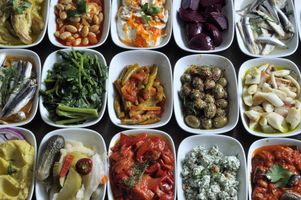
Mediterranean Cuisine: A Way of Life with Remarkable Health Benefits
The Mediterranean cuisine is celebrated worldwide, not just for its delightful flavors but for its profound impact on health and longevity. Often referred to as the "Mediterranean diet," this way of eating is more than just a diet—it's a way of life deeply rooted in tradition, community, and sustainability. The island of Crete, known for its rich culinary heritage, boasts some of the oldest people in the world, showcasing the benefits of this lifestyle.
During my training as a chef, I specialized in Mediterranean cuisine. The variety of dishes, the emphasis on fresh seasonal ingredients, and the well-documented health benefits motivated me to focus on this region. Mediterranean cuisine's combination of simplicity, vibrant flavors, and nutritional value makes it exceptional. Another cuisine with many similarities to Mediterranean food is Middle Eastern cuisine, known for its equally delectable recipes. I'll delve into Middle Eastern cuisine in a future post.
The Essence of Mediterranean Cuisine
Mediterranean cuisine is centered around fresh, seasonal ingredients, simple preparation methods, and a balanced approach to eating. Key ingredients include:
Olive Oil:The cornerstone of Mediterranean cooking, rich in monounsaturated fats and antioxidants, known to reduce inflammation and promote heart health.
Fresh Vegetables and Fruits: A variety of colorful produce forms the base of most meals, providing essential vitamins, minerals, and fiber.
Whole Grains: Staples like whole wheat, barley, and farro offer sustained energy and are linked to reduced risk of chronic diseases.
Lean Proteins: Fish, poultry, and legumes are the primary sources of protein, contributing to muscle health and longevity.
Fresh herbs like basil, oregano, and rosemary, along with spices, not only enhance flavor but also offer numerous health benefits.
Here are the health benefits of Mediterranean Cuisine
Heart Health: Numerous studies have shown that the Mediterranean diet reduces the risk of heart disease. The high content of healthy fats, fiber, and antioxidants keeps the cardiovascular system in top shape.
Longevity: The island of Crete is a testament to the longevity benefits of Mediterranean cuisine. Residents often live well into their 90s and beyond, a fact attributed to their diet rich in fresh, local ingredients.
Weight Management: While not a restrictive diet, the Mediterranean way of eating naturally supports weight management through balanced meals, portion control, and an emphasis on whole foods over processed ones.
Reduced Risk of Chronic Diseases: Regular consumption of Mediterranean foods has been linked to a reduced risk of chronic diseases such as diabetes, certain cancers, and neurodegenerative diseases like Alzheimer’s.
The nutrients found in Mediterranean foods, such as omega-3 fatty acids from fish, contribute to brain health and may help reduce the risk of depression.
It is more than a diet, it's a way of living.
The Mediterranean lifestyle goes beyond what’s on the plate. It’s about enjoying meals with family and friends, being physically active, and maintaining a connection to the land through sustainable practices. This holistic approach contributes to overall well-being and happiness, further enhancing the quality of life for those who embrace it.
Mediterranean cuisine offers a delicious and sustainable way to support long-term health and well-being. Whether you're looking to improve your diet or simply enjoy the rich flavors of this region, adopting elements of Mediterranean cooking into your daily life can be a transformative experience. Remember, it’s not just about the food—it’s about a way of living that has been cherished for centuries.
For a delectable selection of Mediterranean recipes, subscribe to my Recipe Box.
#MediterraneanCuisine #HealthyLiving #MediterraneanDiet #deliciousfood #HealthyEating #HeartHealth #SustainableLiving #MediterraneanWayOfLife

A Guide to Avoiding Fake Olive Oils
Discover the Secrets to Selecting Authentic Olive Oil for Maximum Flavor and Health Benefits
Olive oil, often referred to as liquid gold, is a cornerstone of Mediterranean cuisine, celebrated for its rich flavor and numerous health benefits. However, not all olive oils are created equal. With the rise in popularity of olive oil, the market has seen an influx of counterfeit and low-quality products. Knowing how to choose high-quality olive oil is essential to ensure you're getting the authentic product with all its benefits.
The Importance of High-Quality Olive Oil.
Authentic olive oil is packed with antioxidants, healthy fats, and anti-inflammatory properties, making it a key ingredient in a healthy diet. High-quality olive oil enhances the flavor of your dishes and contributes to better heart health, improved digestion, and even longevity. But with so many options on the market, how can you ensure you're selecting the real deal?
How to Spot High-Quality Olive Oil
There are many fake olive oils on the market, where consumers end up paying a premium price for what they believe is authentic olive oil, but in reality, it isn't.
Check the Label before you buy.
Look for extra virgin olive oil which is the highest quality. It is made from pure, cold-pressed olives, without the use of chemicals or heat.
Also pay attention to the country of origin. Olive oil from countries like Italy, Spain, and Greece are well-regarded, but beware of blended oils from multiple countries, as these may be lower quality.
Look for certifications like the USDA Organic label or Protected Designation of Origin (PDO), which ensure the oil meets strict production standards.
High-quality olive oil is always sold in dark glass bottles to protect it from light, which can degrade the oil's quality.
Avoid plastic or clear glass bottles, as they can allow light and air to enter, causing the oil to oxidize, turn rancid and lose its health benefits.
Another important detail is to check the harvest date on the bottle.
Freshness is key in olive oil. Look for a harvest date on the label and choose oils that are within 18 months of harvest. Older oils may have lost their flavor and nutritional value. Having said this, beware of oils with a vague “best before” date instead of a specific harvest date, as this can indicate a lack of transparency.
Taste and Smell: High-quality olive oil should have a fruity, slightly bitter, and peppery taste. It should not taste greasy, rancid, or musty.
Fresh olive oil has a vibrant, green, and grassy aroma. If the oil smells flat, waxy, or like crayons, it may be old or low-quality.
The Price:
While price alone isn’t always an indicator of quality, extremely cheap olive oil is often a red flag. Genuine extra virgin olive oil requires significant effort to produce, so it’s typically priced accordingly.
How to Avoid Fake Olive Oil
The olive oil industry is notorious for counterfeit products, where oils are diluted with cheaper oils like sunflower or canola, or are mislabeled as extra virgin when they’re not. To avoid fake olive oil make sure you buy it from reputable brands or stores.
I strongly recommend to stick to well-known, trusted brands or specialty stores that prioritize quality.
I am often asked how to buy freshly pressed olive oil at the market, especially from a vendor who produces their own oil.
Here’s what I recommend:
Get to Know the Vendor by establishing a relationship with the vendor. Producers who take pride in their craft will gladly share details about their olive oil, from the type of olives used to the pressing process.
Ask to taste. Freshly pressed olive oil should have a vibrant, fruity taste with a peppery finish. Sampling the oil is a great way to assess its quality before purchasing.
Most market vendors who produce their own oils offer a tasting option. This is a great opportunity to sample the oil before buying, allowing you to experience its flavor, aroma, and quality firsthand. Tasting the oil gives you a better sense of its freshness and authenticity, helping you make an informed decision and ensuring you're getting a product that meets your expectations.
Inquire About the Harvest Date: Freshness is key when it comes to olive oil. Ask the vendor when the olives were harvested and when the oil was pressed to ensure you’re getting the freshest product.
Trustworthy vendors are always open about their production methods.
Whe. Yoi follow these steps, you can confidently purchase freshly pressed olive oil from a market, knowing you’re supporting a producer who truly cares about the quality of their product.
Here are some extra tips to help you assess its quality when buying olive oil from a market vendor who produces their own oil,
Don't be shy and ask questions. For example, ask about the production process, the type of olives used, and when the olives were harvested. Knowledgeable vendors should be able to provide detailed information.
Ask to taste it as many market vendors offer samples. High-quality olive oil should taste fresh, with a balance of fruity, bitter, and peppery notes. If it tastes flat, greasy, or rancid, it’s likely not high quality.
Smell It: Fresh olive oil has a vibrant, green, and slightly grassy aroma. Avoid oils that smell musty, waxy, or off.
Look for Freshness and ask about the harvest date. Olive oil is best when it’s fresh, ideally within 18 months of harvest.
By using these tips, you can make a more informed decision and increase your chances of purchasing a high-quality olive oil. You can also do some research before purchasing.
Choosing high-quality olive oil is essential for both flavor and health. By paying attention to the label, bottle, harvest date, and price, and by trusting your taste and smell, you can rest assure you're getting authentic olive oil. Remember, when it comes to olive oil, quality truly matters.
#OliveOil #ExtraVirginOliveOil #HealthyEating #MediterraneanDiet #CookingTips #FoodieTips #AuthenticOliveOil #HealthyLiving #GourmetCooking

Herb and Spice Pairing Secrets
Discover How to Perfectly Pair Herbs and Spices for Unforgettable Flavor"
Let's talk about a unique spice blend that plays a crucial role in Eastern Mediterranean and Middle Eastern cuisine—Za'atar. This special blend is used in a wide range of dishes, creating a distinct flavor that defines many traditional recipes. Despite its rich culinary heritage, Za'atar is still unfamiliar to many people outside the region.
Za'atar is a combination of dried herbs, sumac, and sesame seeds, creating an earthy, tangy, and slightly nutty flavor profile that enhances everything from breads to meats, and even salads. If you haven't tried it yet, exploring Za'atar could open up a whole new world of flavors in your kitchen. Za'atar is a spice blend that I always keep in my kitchen because I frequently use it when preparing Middle Eastern dishes. Its unique combination of herbs, sumac, and sesame seeds adds a special touch to my cooking, bringing out the authentic flavors of the region. Whether I'm seasoning meats, sprinkling it on flatbreads, or adding it to salads, A go to blend when elevating the taste of my Middle Eastern meals.
During my award-winning cooking classes in Cannes, France, we often explored a variety of Mediterranean dishes. Participants were always fascinated by the use of complex spices like Za'atar, and they frequently asked how to know which spices to use in which dish. Understanding the nuances of Mediterranean and Middle Eastern spices is key to unlocking the authentic flavors of the region. Through hands-on experience, I taught them not only how to use these spices but also how to balance them to create dishes that truly reflect the rich culinary traditions of the Mediterranean.
Don’t make the mistake that I often see when it comes to using herbs and spices—combining too many different fresh herbs and spices that don’t necessarily complement each other. Not all herbs are meant to be mixed together, and some combinations can overwhelm or clash, rather than enhance, the flavors of your dish. By using the correct combination of herbs and spices, you can create a harmonious blend of flavors that will elevate your lunch or dinner, making the dining experience truly memorable. Knowing which herbs and spices work well together is key to mastering the art of Mediterranean and Middle Eastern cooking.
For a complete guide to Mediterranean herbs and spices, check out the herb and spice course on my site. This comprehensive guide will teach you when to use each herb and spice, how to combine them, and how to create delicious Mediterranean meals with ease.
#HerbSpicePairing #MediterraneanFlavors #CulinarySecrets #SpiceBlending #CookingTips #FlavorHarmony #GourmetCooking #MediterraneanCuisine #MiddleEasternFlavors #HealthyEating

Beyond the Tourist Trail: Exploring Amsterdam’s Local Treasures at Noordermarkt
Organic Finds, Vintage Gems, and the True Taste of Amsterdam in Jordaan
Discovering the Charm of Amsterdam’s Noordermarkt: A Local’s Perspective
Every Saturday morning, as the city slowly awakens, I find myself drawn to the Noordermarkt, one of Amsterdam’s hidden gems that offers a completely different vibe compared to the more tourist-heavy Albert Cuyp Market. Tucked away in the heart of the Jordaan district, this market has become my little weekend ritual—a place where the locals gather, the conversations are genuine, and the atmosphere feels like a warm embrace from the city itself. The first thing you notice as you approach the Noordermarkt is the scent. There’s something uniquely comforting about the mingling aromas of freshly baked bread, freshly brewedcoffee, and earthy spices that waft through the air. It’s this sensory experience that pulls you in, urging you to explore every corner. Whether you’re hunting for organic produce, sampling artisanal cheeses, or searching for that perfect vintage find, the market offers something for everyone, all without the overwhelming crowds you might find elsewhere.
What I love most about the Noordermarkt is its authenticity. The vendors, many of whom have been there for years, greet you with a smile and a story. They remember your face, your preferences, and there’s something truly special about that kind of familiarity in a bustling city like Amsterdam. One of my favorite stops is the cheese stall run by a charming couple who are always ready to share tips on various ways to serve their cheeses.
But the Noordermarkt isn’t just about food. As you wander through the stalls, you’ll stumble upon vintage treasures, handcrafted jewelry, and quirky antiques that feel like they’ve been waiting just for you. Each item has a story, and as you chat with the vendors, you start to feel like a part of that story too.
As much as I enjoy the treasures I bring home, it’s the atmosphere that keeps me coming back. There’s something serene about the Noordermarkt that you won’t find at the busier Albert Cuyp Market. Here, you can take your time, sip on a freshly brewed coffee at one of the typical Dutch cafés with a fresh slice of Dutch apple pie. It’s a reminder that, even in a city as vibrant as Amsterdam, there are still places where time seems to slow down, and you can truly savor the moment.
If you’re ever in Amsterdam on a Saturday morning, skip the usual tourist spots and head to the Noordermarkt. Whether you’re a local like me or just visiting, it’s an experience that will give you a true taste of the city’s soul.
#Noordermarkt #AmsterdamMarkets #LocalAmsterdam #HiddenGems
#ExploreAmsterdam #AmsterdamLife #Jordaan #AmsterdamTips
#MarketFinds #TravelAmsterdam #AuthenticAmsterdam #VintageShopping

Classic French Madeleines Recipe: How to Bake Perfect, Buttery Tea Cakes at Home
Discover the Secrets to Making Delicious, Fluffy Madeleines—The Iconic French Tea Cake Perfect for Any Occasion.
Throughout my years as a chef, I've frequently been asked to share the recipe for the beloved French tea cakes. So, here it is—just for you!
Madeleines, the iconic shell-shaped French tea cakes, are a delightful treat that has captivated dessert lovers around the world. These buttery, light, and delicate cakes are known for their distinctive shape and subtle flavor, making them a perfect accompaniment to your afternoon tea or coffee.
The Origin of Madeleines
Originating in the Lorraine region of France, Madeleines have a rich history that dates back to the 18th century. These small cakes were named after a young servant, Madeleine Paulmier, who is said to have created them for King Stanislas of Poland. Today, they are a beloved staple in French pâtisseries and home kitchens alike.
How to Make Classic French Madeleines
Creating the perfect Madeleine requires a few key steps and a special Madeleine pan, which gives the cakes their signature shell shape. Here’s a simple recipe to help you make these delightful tea cakes at home.
**Ingredients:**
- 1/2 cup (115g) unsalted butter, melted and cooled
- 2/3 cup (130g) granulated sugar
- 3 large eggs, at room temperature
- 1 tsp vanilla extract
- 1 cup (125g) all-purpose flour
- 1/2 tsp baking powder
- A pinch of salt
- Zest of 1 lemon (optional for a citrus twist)
Instructions:
1. Prepare the Batter:
- In a mixing bowl, whisk together the eggs and sugar until pale and fluffy. This process should take about 5 minutes using an electric mixer.
- Add the vanilla extract and lemon zest (if using), and mix until combined.
- Gently fold in the flour, baking powder, and salt using a spatula, being careful not to deflate the batter.
- Slowly pour in the melted butter and fold it into the batter until fully incorporated.
2. Chill the Batter:
- Cover the bowl with plastic wrap and refrigerate the batter for at least 2 hours or even better overnight. This step helps to create the characteristic “hump” on the back of the Madeleines.
3. Bake the Madeleines:
- Preheat your oven to 375°F (190°C).
- Butter and flour a Madeleine pan to prevent sticking.
- Spoon the batter into the molds, filling each about 2/3 full.
- Bake for 10-12 minutes, or until the edges are golden brown and the cakes have a slight hump in the middle.
4. Cool and Serve:
- Remove the Madeleines from the oven and let them cool in the pan for a few minutes before transferring them to a wire rack.
- Dust with powdered sugar if desired and enjoy your Madeleines warm or at room temperature.
Enjoying Your Madeleines.
Madeleines are best enjoyed fresh, paired with a cup of tea or coffee. Their tender crumb and buttery flavor make them an irresistible treat that’s perfect for any occasion.This classic Madeleine recipe will bring a touch of French elegance to your baking repertoire, whether you’re a seasoned baker or just starting out. Happy baking!
#FrenchMadeleines
#BakingAtHome
#TeaCakes
#FrenchCuisine
#MadeleineRecipe
#BakingLove
#HomeBaking
#FrenchDesserts
#AfternoonTea
#SweetTreats

Unlock Flavor Mastery: Transform Your Cooking with Herbs and Spices
Discover how to transform everyday meals with bold spices, plant-based enhancers, and umami-rich ingredients to create delicious, well-balanced dishes at home.
If you're passionate about cooking, you already know that great seasoning is the key to elevating your dishes. But mastering the art of seasoning takes your culinary skills to a whole new level, allowing you to explore bold, exciting flavors and stay ahead of the latest food trends. Whether you’re a food lover, a home cook, or someone who enjoys experimenting with global cuisines, understanding how to season properly can turn an ordinary meal into something truly extraordinary.
Why Seasoning is the Heart of Great Cooking
Seasoning isn't just about adding salt; it's about building layers of flavor, enhancing ingredients, and achieving balance in every bite. With modern trends like plant-based cooking, global spice blends, and the growing love for umami, there’s no better time to refine your seasoning skills.
Here are my top tips for mastering today’s seasoning trends
1.Incorporate Global Flavors: Spice up your cooking with seasonings like za'atar, harissa, and gochujang. These international flavors add bold, exciting twists to everyday dishes, making your meals more vibrant and adventurous.
2.Enhance Plant-Based Meals: As plant-based diets grow in popularity, learning to season without relying on animal products is crucial. Nutritional yeast, smoked paprika, and tamari are perfect for adding depth and richness to plant-based dishes without compromising on flavor.
3.Tap Into Umami: Chefs everywhere are using umami-rich ingredients like miso, soy sauce, and mushrooms to bring a savory, full-bodied flavor to their dishes. Adding these can make your meals taste more satisfying and complex.
4.Balance Bold and Subtle: When experimenting with bold spices, don’t forget to balance them with fresh herbs. This contrast creates a well-rounded, dynamic flavor profile that makes every bite memorable.
Seasoning and Modern Food Trends
With the increasing focus on sustainability, plant-based eating, and global fusion, seasoning has never been more exciting or essential to modern cooking. The way we use herbs and spices not only reflects our personal taste but also keeps us connected to the evolving world of food.
Now that you know how seasoning can transform your cooking, here are my final thoughts: Cooking with herbs and spices is one of the simplest and most rewarding ways to enhance your culinary skills. With just a few tweaks, you can transform a basic dish into something extraordinary. Whether you’re new to the kitchen or a seasoned home cook, I encourage you to experiment, explore global flavors, and most of all—have fun with it!
If you’re ready to dive deeper into the world of herbs and spices, I highly recommend checking out my "Cooking with Herbs and Spices" mini course, available in the store right here on the website.
Why You Should Take My Mini Course on Cooking with Herbs and Spices
This course is designed for food lovers and home cooks who want to master the art of seasoning. Whether you’re looking to perfect your everyday meals or experiment with bold, global flavors, this course will give you the tools and confidence to elevate your cooking.
Here’s what you can expect from the course: Step-by-step guidance on how to use both fresh and dried herbs effectively.
● Practical tips for balancing and layering flavors:
● Exclusive recipes that highlight the power of herbs and spices
● Simple techniques to create restaurant-quality meals at home
By the end of the course, you’ll feel confident experimenting with flavors and bringing out the best in your ingredients. So if you’re ready to take your home cooking to the next level, head over to the store and check it out!
#CookingTips #HerbsAndSpices #HomeCooking #FoodLovers #CulinaryCreativity #SeasoningMastery #SeasoningMastery #CookingWithSpices #HomeCooking #GlobalFlavors #PlantBasedRecipes #UmamiMagic #CulinaryTrends #SustainableCooking #FlavorExploration #FoodLovers

From Market to Memory: The Moroccan Tagine That Touched My Soul
A Story of Connection, Tradition, and a Recipe Passed Down Through Generations
Every morning, during my years living in France, I would stroll through the narrow cobblestone streets of Cannes' old town on my way to the bustling Marché Forville. The soft breeze, the sounds of the city slowly waking up, and the sunlight bouncing off the historic buildings made every trip feel special. As I turned the corner toward the market, I would be met with the delicious aromas, vibrant sights, and lively sounds of vendors setting up their stalls. The air was filled with the scent of fresh herbs, ripe fruits, and the buzz of locals going about their day.
Among the many familiar faces at the market was a kind, elderly Moroccan woman who helped her daughter at their fruit and vegetable stall. After the tragic passing of her husband a few months earlier—a loss that shocked us all who frequented the market—she continued to work alongside her daughter. Despite her quiet sorrow, she was always there, greeting customers with a gentle smile and an air of strength.
One morning, she approached me. Although her French was broken—Arabic being her first language—she conveyed her message with warmth and sincerity. She knew I was a chef, and to my surprise, she wanted to share something deeply personal with me: a recipe that had been passed down to her by her mother and grandmother. It was a family recipe, one that had likely been made countless times at family gatherings and celebrations. Now, she wanted me to have it, to make it in my cooking classes. It was a gesture so heartfelt that I immediately felt its significance.
She handed me the recipe, written in her delicate and imperfect French, but the essence of the dish was clear. It was her version of chicken and prune tagine, a dish deeply rooted in Moroccan tradition. Thrilled, I accepted her beautiful gift, knowing that this was more than just a recipe—it was a piece of her family’s heritage. Moroccan cuisine had always fascinated me, and I knew this dish would be a hit with my students and clients.
Over the years, I made the tagine countless times, and it quickly became a favorite. The succulent chicken, cooked with a rich blend of Moroccan spices, fresh herbs, and a sweet prune sauce, was irresistible. I would serve it with fluffy couscous and Moroccan flatbread, Batbout, just as she had described. It’s a dish you’d often come across in Morocco, though each family has their own unique version with secret touches passed down through generations.
As a token of gratitude for her generosity, I always made sure to buy the dried prunes, onions, and cilantro for the dish from her stall. It felt like a small way to honor her and the legacy she had shared with me.
After testing the recipe for the first time, I brought her a small container to taste. I was nervous, hoping she would approve of how I had interpreted her family’s dish. To my relief, she smiled as she tasted it, telling me it was almost exactly how her mother used to make it. Her compliment meant the world to me.
The dish, however, never had a grand name. She simply called it her "chicken and prune tagine." In its simplicity, it carried a timeless beauty. To this day, I cherish that recipe—it’s more than just a meal; it’s a symbol of connection, tradition, and the power of food to bridge cultures.
Now, I’m thrilled to share this special recipe with you in my recipe box on this website. It’s a dish that has brought joy to so many, and I hope it brings the same warmth and delight to your table. Don’t worry if you don’t have a traditional tagine—you can make it in a regular pot, and the flavors will still be just as magical.
This recipe holds a special place in my heart, and I hope you find as much joy in making it as I have over the years.
After Covid, when the market finally reopened, I was eager to return to my favorite stalls, hoping to find familiar faces. But when I arrived at Marché Forville, their stall was no longer there. The space where they used to stand was now an empty gap, a sad reminder of how much had changed. It was in that very spot where the story of this special chicken and prune tagine recipe had begun. That empty space reminded me of the rich memories and connection we shared, now preserved through this cherished dish.
#MoroccanCuisine #FamilyRecipe #ChickenTagine #PruneTagine #TraditionalCooking #CulinaryHeritage #ChefLife #MarketFresh #MarchéForville #TagineRecipe #CookingWithLove #MoroccanFlavors #RecipeBox #CulturalCuisine #FrenchMarket #AuthenticTaste #SlowCooking #CookingStories #FoodWithHistory #HeirloomRecipe #ChefEliane

Labneh: A Creamy Middle Eastern Delight and Delicious Ways to Prepare It
A Delicious Journey in My Mediterranean Cooking Classes
In my Mediterranean cooking classes, one dish always stood out for its simplicity and versatility—Labneh. It wasn’t just a dish we made; it was an experience. Labneh, with its creamy, tangy richness, often became the star of our side dishes, perfectly complementing the vibrant flavors of Mediterranean cuisine. I still remember the excitement that would build as we prepared it together, knowing that the secret to the perfect Labneh is patience.
The Secret to Perfect Labneh
You see, when making Labneh, timing is everything. To achieve that luxurious, velvety texture, I would begin preparing it at least 24 hours in advance. In my kitchen studio, I would carefully scoop out plain full-fat Greek or Turkish yogurt, mixing in with just the right amount of salt, and place it into cheesecloth. The cheesecloth, acting like a gentle sieve, would be hung in the fridge overnight, allowing the excess liquid to slowly drip away. This process transforms the yogurt into the thick luscious Labneh. Straining it for less than 24 hours just wouldn’t give you that same perfect consistency—so trust me, it’s worth the wait. Tip: plan ahead when you want to make labneh.
Versatility on a Plate
When the Labneh was finally ready, the fun would begin. One of the reasons I adore Labneh is its incredible versatility. Depending on the day, I’d guide my students through various ways to dress it up, turning it into the perfect side dish or mezze snack. Labneh is like a blank canvas, just waiting for you to add your own personal touch.
Some days, we’d drizzle the Labneh with high-quality extra virgin olive oil, adding a sprinkle of Za'atar, a fragrant blend of thyme, sumac, and sesame seeds. Other times, we’d stir in fresh herbs like dill and mint, finishing it with a squeeze of lemon and a drizzle of olive oil for a bright, refreshing taste. Each version felt like a little masterpiece, combining simple ingredients to create something truly memorable.
What to Serve with Labneh
As versatile as Labneh is, deciding what to serve it with is just as fun. In class, we would often pair it with warm pita bread, crunchy cucumber slices, or even roasted vegetables. Its creamy texture makes it perfect for dipping, spreading, or simply enjoying by the spoonful.
One of my favorite combinations has always been Labneh with honey and crushed pistachios. This version brings together the tanginess of the Labneh with the sweetness of honey and the crunch of nuts—a true celebration of flavors. For a more savory option, we’d prepare Labneh balls, rolled in spices like paprika or Za’atar and crushed pistachios and serve them as part of a mezze platter with olives, roasted peppers, and grilled meats. And then, there’s Labneh on toast—a delightful, quick breakfast. Whether topped with avocado, tomatoes, or smoked salmon, Labneh offers a refreshing, healthier alternative to traditional cream cheese spreads.
The Joy of Labneh
For me, Labneh is more than just a side dish—it’s a reminder of how something so simple can be transformed into something extraordinary. Making labneh was always one of the highlights of my Mediterranean cooking classes.
The beauty of Labneh lies in its versatility and simplicity. Whether you enjoy it savory or sweet, with herbs or honey, Labneh is a delightful addition to any meal. And the best part? It’s incredibly easy to make at home, requiring only yogurt, salt, and a little patience. Once you’ve mastered it, you’ll find yourself reaching for Labneh again and again, whether it’s for a simple snack or an elegant side dish.
So, the next time you’re in the kitchen, give Labneh a try. Strain it the night before, let it transform, and then unleash your creativity with toppings. You’ll discover that Labneh is a culinary gem that never disappoints.

Discover Labneh: The Creamy Yogurt Cheese That Elevates Every Dish
Labneh, also known as strained yogurt, is a staple in Middle Eastern cuisine and has gained popularity around the globe for its creamy texture, tangy flavor, and versatility. Whether you're new to the world of Labneh or looking to expand your recipe repertoire, this guide will explore what makes Labneh so special and how you can prepare it in delightful ways at home.
What is Labneh?
Labneh is a yogurt-based cheese made by straining yogurt until all the excess whey is removed, resulting in a thicker, creamier consistency. While it resembles cream cheese in texture, Labneh retains the tanginess of yogurt, making it a lighter, healthier option. It's a wonderful ingredient for spreads, dips, and even desserts.
Health Benefits of Labneh
As a dairy product, Labneh is packed with probiotics, essential for gut health, and it's an excellent source of protein and calcium. Additionally, it's lower in fat compared to traditional cheeses like cream cheese or ricotta, making it a great option for those looking to enjoy delicious food while maintaining a healthy diet.
How to Make Labneh at Home
Making Labneh at home is incredibly simple, requiring just two ingredients—plain yogurt and salt. Here's a basic recipe you can try:
Ingredients:
2 cups of full-fat plain Greek or Turkish yogurt
½ teaspoon salt
Instructions:
1. In a mixing bowl, combine the yogurt and salt.
2. Place a cheesecloth over a strainer and pour the yogurt mixture into it.
3. Tie the cheesecloth into a bundle and let it hang over a bowl to drain, or place the strainer over a bowl in the fridge.
4. Allow the yogurt to strain for 24-48 hours, depending on your desired thickness.
5. Once done, transfer the Labneh to an airtight container and store it in the refrigerator for up to a week.
Delicious Ways to Enjoy Labneh
Now that you’ve made your homemade Labneh, the real fun begins—choosing how to serve it! Here are some creative and delicious ways to enjoy this creamy treat.
1. Classic Labneh with Olive Oil and Za’atar
One of the simplest and most popular ways to serve Labneh is to drizzle it with high-quality extra virgin olive oil and sprinkle it with Za’atar, a Middle Eastern spice blend. Serve it with pita bread, fresh vegetables, or alongside grilled meats.
2. Labneh Dip with Fresh Herbs and Garlic
For a more savory twist, mix your Labneh with finely chopped herbs like mint, dill, or parsley, along with minced garlic, and a pinch of salt. This herb-infused Labneh dip pairs perfectly with pita bread, vegetable sticks, or even as a sandwich spread.
3. Labneh Spread on Toast
Labneh makes a fantastic, healthier alternative to cream cheese on toast. Spread it thickly over your favorite bread and top it with sliced avocado, cucumber, or even smoked salmon for a refreshing and nourishing breakfast.
4. Labneh Balls in Olive Oil
If you're feeling adventurous, you can shape your Labneh into small balls after it has fully drained. Roll them in herbs or spices like paprika or za’atar, and store them submerged in olive oil. These Labneh balls are a luxurious addition to any cheese platter or mezze spread.
5. Labneh with Honey and Nuts
For a sweet treat, drizzle Labneh with honey and top it with crushed nuts like pistachios or walnuts. This is a perfect dessert option that is light yet satisfying, offering a delightful balance between creamy, tangy, sweet, and crunchy textures.
Conclusion
Labneh is more than just a Middle Eastern staple—it's a versatile, healthy, and delicious option that can be enjoyed in numerous ways. Whether you like it savory or sweet, on toast, or as part of a mezze platter, Labneh offers endless culinary possibilities. Making it at home is easy, and with these tips, you can enjoy the tangy richness of Labneh any time.
For more recipes and ideas on how to incorporate Labneh into your meals, subscribe to my Recipe Box and explore a world of flavors!
Turkish Labneh
Labneh, while primarily associated with Middle Eastern cuisine, also holds a special place in Turkish cuisine, where it’s celebrated for its creamy texture and tangy flavor. In Turkey, it is often enjoyed as a versatile component in various dishes, whether served as a spread, dip, or accompaniment to main meals.
In your Mediterranean cooking classes, I always insisted on using authentic 10% Greek yogurt when making Labneh. The richness and creaminess that come from full-fat yogurt are essential to achieving the perfect texture and flavor. Using a lighter version just won't give you the same results—it compromises the thick, indulgent quality that makes Labneh so irresistible.
Labneh in Turkish Breakfast (Kahvaltı)
One of the most beloved ways to enjoy Labneh in Turkey is during breakfast, known as kahvaltı. Turkish breakfast is an elaborate affair, featuring an assortment of cheeses, olives, breads, jams, and spreads. Labneh often finds its place alongside these offerings, drizzled with olive oil or honey and served with fresh tomatoes, cucumbers, and herbs. The contrast between the tanginess of Labneh and the sweetness of honey or the richness of olive oil is a simple yet delightful experience.
Labneh Mezze and Appetizers
In Turkish cuisine, mezze—small plates of appetizers—is a central feature, and Labneh is frequently served as part of this spread. Mixed with garlic, olive oil, and sometimes fresh herbs, Labneh becomes a perfect dip for warm pita bread or crisp vegetables. It can also be topped with spices like sumac or pul biber (Turkish red pepper flakes), adding depth and a mild kick to the dish.
Labneh as a Sauce or Accompaniment
Labneh is also used as a cooling accompaniment to spicy dishes in Turkey. It’s common to serve it alongside grilled meats, such as kebabs, or spicy lamb dishes, where its creamy, cooling nature helps to balance out the heat of the main dish. Labneh can also be used as a base for salad dressings, lending its rich flavor to a variety of fresh vegetable combinations.
Labneh in Turkish Desserts
While Labneh is primarily seen as savory, it can also take on a sweet role in Turkish cuisine. Much like in the Middle East, Labneh in Turkey can be sweetened with honey and paired with nuts like pistachios or walnuts for a simple, satisfying dessert.
Labneh’s place in Turkish cuisine is a testament to its versatility and timeless appeal. Whether you’re enjoying it at a leisurely breakfast or using it to complement a hearty meal, Labneh remains an integral part of the Turkish culinary tradition.
#Labneh #MiddleEasternCuisine
#MediterraneanFlavors
#HomemadeLabneh
#LabnehRecipe
#YogurtCheese
#Healthyfood
#TangyTreat #foodlovers
#MediterraneanCooking


Why Every Home Cook Needs a Crockpot: Pressure Cooker and Slow Cooker Benefits for Easy, Healthy Meals
How My Crockpot Became My Kitchen Sidekick: A Chef's Perspective
Having worked as a professional chef for years, I’ve used every tool and gadget you can think of, but few have made as much of a difference in my personal kitchen as my crockpot—a combination of a pressure cooker and a slow cooker. This trusty appliance has become my go-to, not just in my home kitchen, but also in my past cooking classes, where I teached others how to make cooking simpler, faster, and just as flavorful.
Over the years, I’ve come to appreciate the versatility of this tool. Whether I need a meal ready in under an hour or I want to let something simmer gently all day, my crockpot has it covered. The combination of pressure cooking and slow cooking functions makes it a one-stop solution for so many meals.
From the Professional Kitchen to Home: How I Discovered the Crockpot
In professional kitchens, we’re always working against the clock. Whether I was braising meats or preparing big batches of vegetables, speed and efficiency were key. But after years of running a fast-paced kitchen, I wanted something that could give me both speed and the option to slow things down, depending on what my day looked like. That’s where the crockpot came in, and I quickly realized it’s a tool every home cook should have. Now, when I teach my cooking classes, I encourage my students to use tools that help them get the best of both worlds: fast cooking when they’re pressed for time and slow cooking when they want to extract every bit of flavor from their ingredients. The crockpot does just that.
Pressure Cooking: The Quick Fix for Delicious Meals
There’s no denying the magic of the pressure cooker mode. As someone who loves making hearty, rich meals, I find this setting perfect for those days when I need a meal fast. Let’s face it—life can get busy, and even though I enjoy spending time in the kitchen, I don’t always have hours to spare.
With the pressure cooker, I can throw in my ingredients—whether it’s a tough cut of meat or dry beans—and have everything cooked to perfection in a fraction of the time. I used to braise meats for hours in the oven to get that tender, fall-apart texture, but with my crockpot, I get the same results in 30 minutes. It’s not just about convenience; it’s about keeping the flavor, moisture, and nutrients intact.
Slow Cooking: Letting Flavors Develop Slowly
On the flip side, when I’m teaching my students how to build flavors, I often turn to the slow cooker setting. There’s something beautiful about letting ingredients simmer gently over hours, allowing each element to contribute to the overall taste.
When I use the slow cooker in my classes or at home, I emphasize how it creates deeply satisfying meals without much effort. Whether it’s a chicken stew that falls apart after hours of cooking or a rich, slow-cooked soup, the flavors develop beautifully, giving you a meal that tastes like you spent the whole day cooking. In reality, I just set it and forget it!
Teaching with the Crockpot: Why My Students Loved It
When I introduced the crockpot to my students, many were skeptical. They thought it might be too “gadgety” or not something they would actually use. But after showing them how they could make restaurant-quality meals with minimal effort, they were hooked.
Here’s why they love it—and why I recommend it to everyone:
Set It and Forget It: Whether using the pressure or slow cooker mode, once you’ve loaded your crockpot with ingredients, you can walk away. That’s a game-changer for people who feel intimidated by cooking or are short on time. Consistency Every Time: One of the biggest challenges I see my students face is getting consistent results, especially when they’re new to cooking. The crockpot takes away that guesswork. If you follow the cooking times and instructions, you’ll get perfectly cooked meals every time—whether it’s a slow-braised beef stew or a pressure-cooked chicken breast.
Control Over Ingredients: I always tell my students that what goes into your dish is just as important as how you cook it. With the crockpot, you’re able to control every ingredient, which is particularly important for those looking to make diabetes-friendly meals or for anyone watching their intake of salt, sugar, or fat.
How My Crockpot Makes My Life Easier
In my own kitchen, the crockpot has become an essential tool for both everyday meals and when I want to prep for the week ahead. I love that I can use the pressure cooker setting to whip up a healthy dinner in no time when I’m busy, but also rely on the slow cooker setting when I want to plan ahead and let something cook throughout the day.
If you want to batch cooking, the crockpot makes it easier than ever. I can prep a big batch of lentils, chicken breasts, or a hearty vegetable stew, portion it out, and store it in the fridge or freezer. This way, when life gets hectic, I have healthy, homemade meals ready. For me, that’s the real beauty of the crockpot—it helps you maintain balance without sacrificing flavor or nutrition.
Pressure Cooker vs. Slow Cooker: Why My Crockpot Has Both
When I first started using my crockpot, I couldn’t decide which setting I liked better—the pressure cooker or the slow cooker. Now, I love that I don’t have to choose. On those days when I need to get dinner on the table fast, I turn to the pressure cooker setting. On the days when I have more time or want to build deeper flavors, the slow cooker option is my best friend. Having both settings in one appliance makes it flexible and adaptable to my needs, whether I’m teaching a class or preparing meals for myself. It’s like having two indispensable tools in one, and that’s why I can’t stop raving about it.
Final Thoughts on why every home cook needs a crockpot
As someone who’s spent years working in professional kitchens and teaching others how to cook, I can confidently say that my crockpot is one of the most useful tools in my kitchen. It’s not just a convenience—it’s a way to cook smarter, not harder. Whether you’re looking to save time, simplify meal prep, or take the stress out of cooking, the crockpot has you covered.
So if you’re looking to make life in the kitchen a little easier, trust me, a crockpot—with its dual pressure cooker and slow cooker settings—will change the way you cook. It’s made my life easier, and I’m sure it will do the same for you.
#CrockpotCooking #PressureCookerMeals #HomeCookingMadeEasy #StressFreeCooking
#PressureCookerRecipes #BusyDayMeals #TimeSavingTips

Locking the lid, it's ready to cook!

Effortless Meal Prep: Simplify Your Week with Delicious, Healthy Meals
Take the stress out of cooking with simple tips for batch cooking, portion control, and quick meal prep.
Save Time, Eat Well, and Enjoy More Free Time
Meal prep doesn’t have to be complicated or time-consuming. In fact, with a few simple tricks, you can set yourself up for success in the kitchen and enjoy healthy, delicious meals throughout the week—without spending hours cooking each day. As someone who’s spent years in the culinary world, I’ve learned a thing or two about effortless meal prep, and I’m excited to share my favorite tips with you.
Whether you’re juggling work, family, or simply want more free time, meal prepping can help you stay on top of your nutrition goals and make your week a little easier.
Why Meal Prep?
If you’ve ever come home after a long day and felt too tired to cook, you know how tempting it is to reach for something quick—often sacrificing nutrition for convenience. Meal prepping solves that problem by giving you ready-made, healthy options at your fingertips.
▪︎ Planning and prepping meals in advance also helps with:
▪︎ Time management: No more last-minute scrambling for dinner.
▪︎ Portion control: Avoid overeating by portioning out meals ahead of time.
▪︎ Reduced stress: Know what’s on the menu, without decision fatigue.
▪︎ Balanced nutrition: Stay committed to healthy eating habits.
My Top Tips for Effortless Meal Prep
Over the years, I’ve developed a few tried-and-true techniques to streamline the process. Here’s how you can prep like a pro:
● Batch Cooking is Your Best Friend One of the easiest ways to simplify meal prep is by batch cooking. Prepare large quantities of staples like grains, proteins, and vegetables that can be used in multiple meals. Roast a tray of mixed veggies, cook a big pot of quinoa or rice, and grill chicken or fish. You can mix and match these ingredients to create different meals throughout the week without getting bored.
● Use Time-Saving Kitchen Tools My go-to tool for effortless cooking is the slow cooker or pressure cooker—perfect for set-it-and-forget-it meals. I love tossing in my ingredients, turning it on, and getting back to work, knowing a warm, flavorful dish will be ready in a few hours. These appliances are lifesavers for busy people who still want to eat home-cooked, healthy meals.
● Prep Veggies Ahead of Time If you find yourself avoiding veggies because of all the chopping involved, try preparing them ahead of time. Wash and chop your vegetables in bulk and store them in airtight containers. Pre-cut carrots, peppers, cucumbers, and leafy greens can be used in salads, stir-fries, or even as quick, healthy snacks.
● Portion Meals for Grab-and-Go Convenience After you’ve prepped your meals, divide them into individual portions. This makes it easy to grab a perfectly portioned, balanced meal when you’re on the go or in a hurry. I often portion out my lunches and dinners in glass containers for the week—it’s a great way to avoid the temptation of eating out.
● Create Versatile, Mix-and-Match Meals Keep things exciting by preparing versatile ingredients that can be combined in different ways. Think grilled chicken that works in salads, wraps, or paired with grains and roasted veggies. Or cook a batch of lentils to use in soups, salads, and even breakfast bowls.
Healthy, Delicious Meals Without the Stress
The beauty of meal prepping is that you don’t need to sacrifice flavor for convenience. In fact, when you plan ahead, you’ll likely find that your meals are more delicious and satisfying because you’ve put thought into them. Plus, knowing that you have healthy, balanced meals ready to go can help you stay on track, whether you’re focusing on diabetes-friendly eating or just trying to maintain a balanced diet.
Start Simple, Build the Habit
If you’re new to meal prep, don’t feel pressured to do everything at once. Start with one or two days’ worth of meals and build from there. The goal is to make your life easier, not more complicated.
Meal prep has been a game-changer for me, both as a chef and in my personal life. With a little planning, you’ll find that eating well can be effortless. And the best part? You’ll have more time to enjoy the things you love.
For healthy recipes, subscribe to my recipe box on this website (coming soon)


Reviving the Retro: Meatloaf is Back and Better Than Ever
Bringing a vintage favorite back to the table with a delicious modern update.
The Recipe:
2 Ibs lean, good quality, ground beef
1onion, diced
2 eggs, lightly beaten
3 tbsp garlic cloves, minced
2 tsp ltalian or French Provençal seasoning
½ tsp paprika
4 tbsp ketchup
1 tbsp Worcestershire sauce
4 tbsp fresh flat leaf parsley, finely chopped
3/4 cup breadcrumbs, Panko (Japanese bread crumbs)
½ cup whole milk
½ tsp finely ground black pepper
2 tsp salt
Sauce
1 cup ketchup
2 tsp white vinegar
2 tbsp light brown sugar
2 tsp garlic granules or powder
2 tsp onion powder
Salt,to taste
Finely ground black pepper, to taste
Preparation:
Preheat oven to 190°C/ 375° F. • Brush a loaf plan with olive oil all the way to the edges and set aside. • In a large bowl, combine the ground beef, eggs, garlic, onion, ketchup, Worchestershire sauce, parsley, breadcrumbs, milk, Italian of French Provençal seasoning, paprika, salt and black pepper. Mix with your hands until well combined. • Place the mixture into the prepared loaf pan. Bake at 190°C or 375° F for 40 minutes. Meanwhile, prepare the meatloaf sauce. In a small bowl, mix ketchup, white vinegar, brown sugar, garlic powder, onion powder, salt, and black pepper. Whisk until ingredients are well combined. After 25 minutes, spread the top of the meatloaf and finish baking for 15 minutes • Remove frommoven and let it rest for 5 minutes sprinkle with parsley and serve.
Enjoy
#RetroMeatloaf #ClassicRecipes #NostalgicEats
#MeatloafComeback #ComfortFoodFavorites
#EasyMeals #HeartyDinners
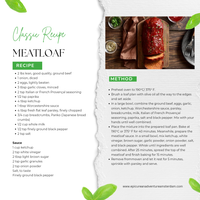
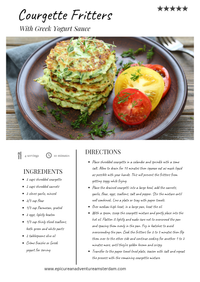
These vegan courgette fritters are one of my favorite easy and tasty go-to snacks! Perfectly crisp on the outside, tender on the inside, and packed with fresh flavors, they’re a quick and satisfying bite for any time of day. Whether you're craving a light snack or a simple vegetarian meal, these fritters are sure to hit the spot! Served with a refreshing yogurt sauce.
#VeganFritters
#EasyVeganMeals
#MeatlessMonday
#PlantBasedRecipes
#VeganAppetizer
#VeganEats

My Tuscan Shrimp in Creamy Basil Sauce – Mediterranean Magic in Under 30 Minutes
When I visited Tuscany a few years ago, I had the most incredible shrimp dish, and I knew I had to recreate it with my own twist. Fast forward to today, and my Tuscan Shrimp in Creamy Basil Sauce has become a favorite in my kitchen. This recipe brings together all the best Mediterranean vibes with creamy, flavorful goodness – and the best part? It’s ready in under 30 minutes. Perfect for a quick dinner when you want something a little fancy without the fuss.
Why This Recipe is a Must-Try
You know when you take a bite, and it instantly transports you somewhere? That’s what this dish does for me. Every time I make this shrimp in creamy basil sauce, I’m right back in Tuscany, where the flavors are fresh, and the ingredients do all the talking. This recipe combines juicy shrimp with a rich, garlicky basil sauce and sun-dried tomatoes that add just the right amount of tang. Whether you're cooking for yourself, friends, or even a date night in, this dish is a total win.
Why This Recipe Slaps:
▪︎ It's quick & fancy: Ready in under 30 minutes, it’s perfect for when you want something delicious but don’t want to spend hours in the kitchen.
▪︎ Flavor Explosion: The combo of garlic, creamy sauce, shrimp, and basil hits all the right notes.
▪︎ Inspired by my travel: This dish takes me back to my time in Tuscany, and now you can bring a little piece of that magic home too.
▪︎ It’s versatile: Serve it with pasta, rice, or even zoodles if you’re feeling healthy.
You won’t believe how easy it is to pull this together. See the recipe below.
Pro Tips:
Fresh is Best: Fresh basil and shrimp really make the flavors pop. If you have the option, go fresh!
Don’t Overcook the Shrimp: They cook fast! Keep an eye on them to avoid rubbery shrimp.
Adjust the Sauce: If you prefer a thicker sauce, let it simmer a bit longer.
Perfect Pairings:
● Wine: A crisp white like Pinot Grigio or Sauvignon Blanc works perfectly, but if you’re a red wine fan, a light-bodied Pinot Noir will do the trick.
● Sides: Garlic bread, fresh pasta, or a simple green salad – anything that can soak up this amazing sauce!
The Health Benefits of Shrimp:
Shrimp is low in calories, high in protein, and packed with nutrients like selenium and vitamin B12, making this dish not only tasty but a great choice for a well-rounded meal. Plus, fresh basil and garlic bring added health perks like antioxidants and anti-inflammatory properties. Healthy and delicious – the ultimate win.
Final Thoughts
My Tuscan Shrimp in Creamy Basil Sauce is one of those dishes that just feels special. Every bite brings me back to Tuscany, and I love sharing that experience through this recipe. It’s quick, flavorful, and perfect for any occasion – whether you’re cooking for yourself or trying to impress someone. Give it a try and let me know how it turns out! And don’t forget to snap a pic for Instagram – tag me so I can see your delicious creation!
#TuscanShrimp
#CreamyBasilSauce
#QuickDinnerIdeas
#MediterraneanFlavors
#ShrimpRecipe
#EasyGourmet
#GenZCooks
#MediterraneanVibes
#WeeknightDinner
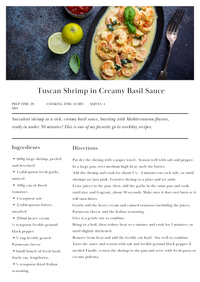

Elevate Your Holiday Feast: My Christmas Cooking Course with Exclusive Recipes – Coming Soon!
Want to wow your friends and family this holiday? My Christmas Cooking Course is packed with exclusive, Insta-worthy recipes that are super easy to follow and guaranteed to impress. Whether you're cooking for a big crew or just making a cozy dinner, these dishes will take your holiday game to the next level. Coming soon – don’t miss out on making this Christmas your best one yet
#HolidayFeast
#InstaWorthyRecipes
#ChristmasCooking
#FestiveFlavors
#CookLikeAPro
#FoodieInspo
#EasyHolidayMeals
#ExclusiveRecipes
#NextLevelCooking
#ImpressYourGuests

Keshi Yená Recipe: A Delicious Curaçao Classic with Rich Island Flavors
Learn How to Make Authentic Keshi Yená, a Savory Cheese-Stuffed Dish Perfect for Family Dinners and Caribbean Cuisine Lovers
For the Filling:
Prepare the Chicken:
Rub 200 grams of chicken breasts and 200 grams of chicken thighs with a few limes.
Season with salt, pepper, and poultry seasoning to taste.
Marinate for 4-5 hours.
Cook the Chicken:
In a large pan, melt 3 tablespoons of butter over medium heat.
Brown the marinated chicken until golden.
Transfer the chicken to a large pot with 1 quart of water.
Add:
▪︎ 1 tablespoon salt
▪︎ 6 peppercorns
▪︎ 1 medium onion
▪︎ 1 celery stalk, cut into chunks
▪︎ 1 bruised bay leaf
Bring to a boil, then reduce heat and simmer for 20 minutes, until the chicken is tender.
Strain the broth and set aside. Discard the vegetables.
Debone the chicken, remove the skin, and set the meat aside.
3. Make the Sauce:
Peel and chop 2 tomatoes.
In a large pan, melt 3 tablespoons of butter over medium-high heat.
Add the chopped tomatoes and sauté.
Add:
▪︎ 1 sliced onion
▪︎ 1 sliced green pepper
▪︎ 1 tablespoon chopped flat-leaf parsley (leaves only)
▪︎ A few drops of Tabasco sauce
▪︎ Salt and pepper to taste
Stir in:
▪︎ 1 tablespoon ketchup
▪︎ ¼ cup sliced pimento-stuffed olives
▪︎ ½ tablespoon capers
▪︎ ¼ tablespoon piccalilli
▪︎ The cooked chicken
Simmer for 15-20 minutes, then remove from heat and let cool.
Assemble the Keshi Yená:
1. Generously butter 4 ramekins or 1 large soufflé dish.
2. Line the sides and bottom of each with thin slices of cheese
3. Add the chicken mixture and cover the top with a slice of cheese, ensuring it’s completely covered.
4. Place the ramekins or soufflé dish in a large pot. Carefully add hot water to the pot, filling it halfway up the sides of the ramekins or dish.
5. Cover the pot with a lid and steam for about 15 minutes, until the cheese is melted.
To Serve:
1. Let the Keshi Yená cool for 3-5 minutes.
2. Gently run a knife around the edges to loosen the cheese, then invert onto a plate
Serve with white rice, slices of plantain, and steamed vegetables. Enjoy!
👩🍳 Chef's note: instead of chicken, you can also make it with ground beef.

Curaçao's famous floating market.

Stress-Free Holiday Entertaining: How to Create a Beautiful Spread and Perfect Table Setting
Effortless Holiday Entertaining: Create a Beautiful Spread and Stress-Free Table Setting
The holiday season is a time for joy, laughter, and coming together with friends and loved ones—but for many, it also brings the stress of planning and entertaining. I’ve been there, watching my mother, a French gourmet cook, expertly prepare for Christmas and New Year’s weeks in advance, carefully crafting the menu and designing the perfect table setting. My father shared her love for entertaining, and their passion for hosting was truly inspiring. When I got married, I continued the Christmas tradition in our home, bringing the same warmth and care to every gathering. Many years later, when I opened my restaurant in Cannes, France, I embraced those same traditions. Each year, I delighted in selecting a unique table setting and crafting a menu that would delight the guests and make the season unforgettable.
Today, I’m sharing tips to help you take the stress out of holiday entertaining while still creating a beautiful, welcoming atmosphere for your guests. With some thoughtful planning, you can enjoy the festivities without feeling overwhelmed. Here’s how to create a gorgeous spread and set a stunning dinner table that will make your holiday gatherings unforgettable.
Plan Ahead for a Stress-Free Holiday
The secret to effortless holiday entertaining is all in the preparation. Here are my top tips for getting organized well in advance:
1. Craft Your Menu Early: Just like my mother, start planning your holiday menu weeks ahead. Think about dishes that can be prepared in advance, leaving you with more time to enjoy your guests. A mix of make-ahead appetizers, festive salads, and slow-cooked main courses can save you a lot of last-minute stress.
2. Choose a Theme: Selecting a theme or color palette can guide your menu and décor choices. Whether it’s a classic red and gold Christmas theme or a winter wonderland with frosty whites and silver, a cohesive look will elevate the ambiance. It’s a trick I often used at my restaurant to keep the decor fresh each year.
3. Prep in Batches: Break down your to-do list into manageable tasks over a few weeks. For example, you can marinate meats a day ahead, prepare desserts a few days in advance, or chop veggies two days before and vacuum seal to keep this freshness until ready to use. This helps avoid that overwhelming feeling on the big day.
Create a Beautiful Spread Without the Fuss
A gorgeous holiday spread doesn’t have to be complicated. Focus on a few standout dishes and make them shine:
1. Feature a Signature Dish: Choose one or two dishes that will be the star of your table, like a savory roast or a stunning charcuterie board. Make these the focal point, and then complement them with simpler sides and salads. This approach makes entertaining feel more manageable.
2. Incorporate Seasonal Ingredients: Using in-season ingredients not only ensures freshness but it's also cheaper buying in season and it adds a festive touch to your spread. Think of roasted butternut squash, pomegranate seeds, or caramelized Brussels sprouts. These vibrant colors can elevate even the simplest dishes.
3. Buffet Style for Easy Entertaining: If you’re hosting a larger group, consider serving buffet style. It’s an informal yet elegant way to let guests serve themselves, which means less time spent in the kitchen for you. I love creating a mix of hot and cold dishes so guests can enjoy at their own pace.
Set a Stunning Holiday Table
A well-set table is just as important as the food itself—it sets the mood for the entire evening. Here’s how to create a stunning, stress-free tablescape:
1. Mix High and Low: Don’t worry about everything matching perfectly. Mix in heirloom pieces with modern touches for a look that feels warm and lived-in. Think of using your best china with a simple linen table runner, or pairing crystal glasses with rustic wooden chargers.
2. Use Nature for Décor: Incorporate natural elements like pinecones, fresh greenery, or dried citrus slices for an elegant, yet cost-effective way to decorate. Scatter some candles throughout for that warm, cozy glow. In my restaurant days, I loved placing sprigs of rosemary or fresh herbs at each place setting—they look lovely and add a pleasant aroma.
3. Personalize with Place Cards: Adding a personal touch like beautifully handwritten place cards or small favors can make guests feel extra special. It’s a simple gesture that goes a long way. For a twist, you could even use Christmas ornaments as place card holders.
Enjoy the Moment
With these tips, you’ll find that holiday entertaining can be both beautiful and stress-free. The holidays are a time to create memories with those you love, and with a bit of thoughtful planning, you’ll be able to relax and enjoy the magic of the season. Remember, the best gatherings aren’t about perfection—they’re about the warmth and connection that come from being together.
So, light those candles, pour a glass of wine, and celebrate the season with ease. Here’s to a joyous and beautiful holiday season, filled with delicious food, laughter, and cherished moments around the table.
Happy holidays and bon appétit!


Ever Tried a Stovetop Smoker? Here’s How to Use It and What You Can Make!
Discover the Magic of Stovetop Smokers: Why I Use Them and What You Can Cook
While I don’t use my stovetop smoker every day, it’s a tool I turn to when I’m looking to create specific smoky flavors in certain dishes. For me, it’s not about loving smoke in everything I eat, but when the craving hits for that rich, wood-fired flavor—especially in fish, chicken, or even some veggies—this compact smoker does the trick. If you're interested in adding just the right amount of smokiness to your meals without firing up an outdoor grill, a stovetop smoker might be a good fit for your kitchen too.
What is a Stovetop Smoker?
A stovetop smoker is essentially a small metal pan with a rack inside for your food and a lid to trap the smoke. You add wood chips at the bottom, and with just a bit of heat, you can infuse food with the delicious smoky flavor usually reserved for outdoor smoking. It works on any type of stove, which makes it really versatile for home kitchens.
Why I Use My Stovetop Smoker
1. Indoor-Friendly: Sometimes, outdoor smoking just isn’t practical, especially in bad weather or if you don’t have the space. With a stovetop smoker, you can get that smoky touch indoors, rain or shine.
2. Quick Results: Smoking outdoors can take hours, but with a stovetop smoker, I can have beautifully smoked salmon, chicken, or vegetables in under an hour. It’s great when I want a quick hit of smoke without a full-day commitment.
3. Healthier Cooking: Smoking adds tons of flavor, which means I don’t have to rely on heavy sauces or extra fats. Plus, since I control the ingredients, there’s no need for preservatives or artificial flavors like you might find in store-bought smoked items.
4. Compact and Convenient: My stovetop smoker is easy to store and takes up hardly any space, so it’s perfect for those moments when I want to smoke something without having to deal with a large, bulky appliance.
5. Versatility: While I don’t love smoky flavors in everything, I do enjoy using the smoker for specific dishes, and it’s great for experimenting. From meats to cheeses, I’ve discovered a variety of foods that really shine when smoked.
What I Cook in My Stovetop Smoker
1. Smoked Salmon
One of my favorite dishes to make in the stovetop smoker is smoked salmon. It’s quick, taking about 20 minutes, and the result is tender, flavorful salmon that’s great for breakfast, lunch, or dinner. I love it on bagels with cream cheese or tossed into salads.
2. Smoked Chicken or Duck Breast
For a lean, flavorful protein, I often smoke chicken breasts. It’s healthier than frying, and the smokiness adds a depth that makes it feel a little more special. I usually pair it with simple sides like roasted veggies or grains.
Note: you don’t need to cook the chicken breast before placing it in the smoker. The smoking process will cook the chicken as it infuses the smoky flavor. Just make sure the internal temperature of the chicken reaches at least 165°F (75°C) to ensure it's fully cooked. You can season the raw chicken breast before placing it in the smoker, and it will come out tender and flavorful.
For chicken breasts in a stovetop smoker, it typically takes about 25 to 45 minutes, depending on the thickness of the meat and the heat level. It's important to check the internal temperature with a meat thermometer to ensure it reaches 165°F (75°C) for safe consumption. Thinner breasts may cook faster, while thicker ones may need a bit more time. If you prefer a quicker cook time, you can also sear the chicken breasts in a pan on the stovetop before placing them in the smoker to finish cooking and develop that smoky flavor.
3. Smoked Vegetables
While I’m not a fan of smoky flavors in everything, smoked veggies are one area where the stovetop smoker really works for me. Zucchini, bell peppers, and even eggplant take on a lovely richness when smoked, and they’re perfect for adding to salads or serving alongside a main dish.
4. Smoked Cheese
For something a little different, I’ll sometimes smoke gouda. It’s an interesting twist on regular cheese, and I find it’s fantastic when served on a charcuterie board or melted into sandwiches.
5. Smoked Nuts
Smoked almonds or cashews are a fun snack to whip up when I have guests over. They’re quick and easy to prepare, and the smoky flavor is subtle but adds a nice dimension to a simple snack.
Smoking mackerel is a fantastic option too—it's rich, flavorful, and perfect for a stovetop smoker. Here's a quick addition:
6. Smoked Mackerel
Mackerel is another delicious fish to smoke in a stovetop smoker. Its natural oils soak up the smoky flavor beautifully, resulting in tender, flavorful fillets that work well on toast, in salads, or even in a pâté. It only takes around 20-30 minutes, making it an easy and flavorful dish to prepare.
How to Use a Stovetop Smoker
Using a stovetop smoker is simple:
1. Add Wood Chips: Place a couple of tablespoons of wood chips (I usually go for hickory or applewood) in the bottom of the smoker.
2. Place Your Food: Arrange your food on the rack. Don’t overcrowd it—give everything room to absorb that smoky flavor.
3. Heat It Up: Set your stovetop to medium heat. Once the wood chips start smoking, lower the heat a bit and let the smoker do its thing. Most dishes take between 20 minutes to an hour, depending on the food.
4. Enjoy: When your food is ready, remove it from the smoker and enjoy that smoky flavor!
Why It’s Worth Trying
Even if you’re not a huge fan of smoky flavors, a stovetop smoker is great for experimenting with certain dishes that benefit from that added depth. It’s easy to use, quick, and doesn’t require a lot of space or effort. If you’re curious about creating smoky flavors at home without going full-on with outdoor smoking, give it a try!
#StovetopSmoker #HomeCooking #SmokedSalmon #SmokedChicken #HealthyCooking #QuickMeals #FlavorfulFood #SmokedVeggies #CompactKitchenTools #EasyCooking #Foodie
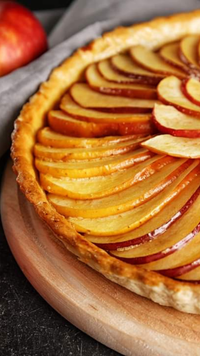
French Apple Tart with Caramelized Apples and Creamy Custard
This classic French dessert combines a buttery crust with perfectly caramelized apples, finished with a rich custard—perfect for any special occasion or cozy evening at home.
Ingredients for Shortcrust Pastry:
▪︎ 200g plain flour
▪︎ 100g unsalted butter, diced and at room temperature
▪︎ A pinch of salt
▪︎ 1 medium egg
▪︎ 1 tablespoon cold water
Ingredients for the Filling:
▪︎ 3 apples, peeled, cored, and sliced into 10-12 wedges each
▪︎ 15g unsalted butter, melted
▪︎ 15g fine sugar
▪︎ 1 ½ tablespoons fresh lemon juice
▪︎ A little splash of Calvados (optional)
▪︎ 1 medium egg
▪︎ 50g fine sugar
▪︎ 100ml whipping cream
▪︎ Icing sugar, for dusting
Preparation:
▪︎ In a large mixing bowl, combine the flour, butter, and salt by gently rubbing the ingredients between your fingers until the mixture resembles coarse sand.
▪︎ Make sure the butter is at room temperature and soft, which helps it blend evenly into a crumbly texture.
▪︎ Form a well in the middle of the mixture, then add the whole egg and egg yolk.
▪︎ The eggs not only add moisture and richness but also improve the dough’s structure and help bind everything together.
▪︎ Using your fingertips, gently work the egg into the flour and butter mixture in small circles. Once the egg is absorbed, gather the dough and press it together into a ball.
▪︎ Lightly dust your work surface with flour, and knead the dough with the palms of your hands for about 20 seconds, just until it's smooth and consistent. Be careful not to overwork it, as this can make the pastry less flaky and cause it to shrink during baking. ▪︎ ▪︎ Set aside 20-30g of the dough, wrap it in cling film, and you're ready to go!
Flatten the remaining dough into a round, about 2cm thick—this helps it chill and rest more quickly and makes it easier to roll out. At this stage, the dough will be a bit elastic due to the gluten, but chilling it will make it more pliable and help reduce shrinkage during baking. Wrap the dough in cling film and place it in the fridge to rest.
Lining the Tart Ring:
Preheat your oven to 210°C/190°Fan.
Lay a sheet of cling film (40cm x 40cm) on your work surface, place the dough in the center, and cover it with another sheet of cling film. Roll the dough out to a thickness of about 2-3mm.
Rolling the dough between cling film sheets allows you to achieve a very thin pastry without needing to dust with flour, and it prevents the dough from sticking to your surface. Once the dough is rolled out, you can easily lift it and transfer it into the tart ring. After rolling to the desired thickness, remove the top layer of cling film, carefully lift the dough, and drape it over the tart ring. Remove the remaining cling film. Gently lift the edges and press the dough into the ring.
Now, use the reserved ball of dough to press the dough down firmly and line the bottom of the tart ring, ensuring the dough fits perfectly. This step helps minimize shrinkage and prevents the dough from collapsing. Trim the excess dough by rolling a pin over the top of the ring, from the center outward.
Next, raise the edge of the dough about 2mm above the rim by gently pushing the pastry with your fingers, working your way around the tart ring. Prick the bottom of the tart with a fork to prevent it from puffing up while baking. Let the lined tart ring rest in the fridge for 20-30 minutes to relax the dough.
For the Filling
Arrange the apple slices in a neat, overlapping pattern inside the tart shell. In a small bowl, mix the melted butter, sugar, and lemon juice (plus Calvados, if using), and brush this mixture generously over the apples. Dust the apples with a good amount of icing sugar—this will melt and caramelize as it bakes.
Place the apple tart in the oven and bake for 20 minutes. While it’s baking, whisk together the egg, sugar, and whipping cream to make the custard. After 20 minutes, pour the custard over the apples and continue baking for an additional 10 minutes, until the apples are a beautiful amber color and the custard slightly puffed, and the pastry nice and golden.
Remove the tart from the oven and allow it to cool for about 30 minutes. Dust with icing sugar before serving.
Tip: Serve with a scoop of vanilla bean ice cream of a dollop of crème fraiche.
#FrenchDesserts #AppleTart #BakingAtHome #CaramelizedApples #baking

The Ultimate Guide to Perfect Yorkshire Pudding: Crispy, Golden, and Delicious Every Time
Discover the secrets to making the best Yorkshire puddings for your Christmas feast. Get the full recipe in my upcoming Christmas Recipe Collection Cookbook!
The Secret to Perfect Yorkshire Pudding: My Essential Tips
If you’re looking for the key to perfect Yorkshire puddings, you’ve come to the right place. This beloved British side is a staple in my kitchen, especially when it comes to my Christmas menu. Whether you’re pairing it with a roast or serving it up with rich gravy, Yorkshire puddings add that comforting, golden-crisp touch that everyone loves. Over the years, I’ve fine-tuned my approach, and today, I’m sharing my tried-and-true tips so you can master this classic dish too. You’ll find the full recipe in my Christmas Recipe Collection Cookbook, which will be available soon!
Why Yorkshire Pudding?
Yorkshire pudding is more than just a side; it’s a showstopper. The way it rises in the oven, crispy on the outside with a soft and light interior, makes it a favorite at my holiday table. It’s especially perfect for soaking up gravy and adds a hearty, satisfying element to any meal. The best part? They’re simpler to make than you might think. Here are my top tips to ensure your puddings turn out perfectly every time.
My Essential Tips for Perfect Yorkshire Puddings:
1. Rest the Batter
One of the most important steps in creating light, crispy Yorkshire puddings is letting the batter rest. After whisking together the eggs, flour, milk, and a touch of water, give it at least 30 minutes at room temperature. If you can plan ahead, refrigerating the batter overnight makes a noticeable difference. Just be sure to bring it back to room temperature before baking.
2. Use the Right Fat
Traditionally, beef drippings are used, and trust me, they give Yorkshire puddings an incredible flavor. But if you’re going for a lighter option, lard or even vegetable oil works well too. Just make sure the fat is piping hot when you pour in the batter—that’s the secret to getting that beautifully puffed rise.
3. Preheat Everything
This is where a lot of people go wrong. You’ve got to preheat both your oven and the tins with the fat. I always make sure the fat is smoking hot before I add the batter. The heat is what gives the Yorkshire puddings their signature crispy exterior and fluffy center. I usually set the oven to 230°C/450°F/210° Fan to get the perfect result.
4. Don’t Peek!
I know it’s tempting, but resist the urge to open the oven door while they’re baking. Opening the oven too soon can cause them to deflate, and you’ll lose that wonderful rise. Wait until they’re golden brown and crisp before checking. Smaller ones will take around 15 minutes, while larger puddings need closer to 25 minutes.
5. Fill the Tins Just Right
It’s all about balance. When pouring the batter, fill each tin about halfway. If you overfill, your puddings will be too dense, but underfilling can make them too small and lack that perfect texture. Aim for a half-full tin, and you’ll get that perfect rise every time.
6. Freeze for Later
Want to save some time on the big day? Yorkshire puddings freeze beautifully. After baking, let them cool completely, then freeze in a zip-lock bag. When you’re ready to serve, pop them in a hot oven, and they’ll be just as crisp as if they were freshly made.
My Holiday Tradition
In my house, Yorkshire puddings gained popularity on my Christmas menu. There’s something so special about serving these golden beauties alongside a rich roast and gravy. They’ve become a bit of a tradition for me, and I love how they bring that comforting, festive touch to the table.
If you’re looking for more delicious Christmas recipes, don’t forget to check out my Christmas Recipe Collection Cookbook, launching soon. It’s packed with festive favorites, including my full Yorkshire pudding recipe, plus plenty of tips to make your holiday stress-free and delicious!
#YorkshirePudding
#ChristmasRecipe
#HolidayCooking
#CrispyYorkshirePudding
#ChristmasDinnerIdeas
#ChristmasRecipeCollection

Unleash the Ultimate Holiday Entertaining Experience with Luxurious Cheese & Charcuterie Boards
This holiday season, elevate your gatherings with an artisanal cheese and charcuterie board paired with exquisite wines. Discover the irresistible Port and blue cheese duo for a show-stopping, unforgettable flavor experience.
Effortless Entertaining with Cheese & Charcuterie Boards: A Perfect Choice for Small Gatherings
When it comes to easy entertaining, few things can rival the charm and simplicity of a well-crafted cheese and charcuterie board. It's one of my favorite ways to host, especially for small groups. The variety of textures and flavors allows guests to sample and savor, creating a relaxed, communal atmosphere. Whether I’m putting together a tapas-style spread or focusing on a selection of fine cheeses and cured meats, a charcuterie board never fails to impress.
However, having lived and worked in France for many years, there is one golden rule I always follow: cheese is never served before dinner. In French culture, cheese is a cherished part of the meal, but it’s reserved for after the main course – never before. It’s a tradition I’ve carried with me, and one I strictly adhere to. For me, cheese before dinner is simply not done. Instead, I only serve a cheeseboard when guests come over for drinks. It pairs perfectly with wine and creates a relaxed, social atmosphere that invites conversation.
How I Craft the Perfect Cheese & Charcuterie Board
Creating a well-balanced board is all about variety and contrast. I like to offer a selection that caters to different tastes and textures, making sure there's something for everyone. Here’s how I typically approach it:
Cheeses: While I never serve cheese before dinner when hosting, for a cheese and charcuterie board, I opt for a mix of soft, semi-hard, and aged varieties. Think Brie, Comté, and a bold Roquefort. The goal is to provide a range of flavors and textures that complement the other elements on the board.
Cured Meats: Prosciutto San Daniele, salami, and chorizo are my top choices. Each brings a unique flavor, from salty and rich to spicy and smoky. I slice them thin and arrange them in delicate folds for an elegant presentation.
Seasonal Fruits: Fresh figs, grapes, or sliced apples bring sweetness and a pop of color to the board. Dried fruits, like apricots or dates, are another great addition that pairs well with both cheese and meats.
Crunchy Elements: Nuts like almonds, walnuts, or pistachios provide a satisfying crunch. They also pair beautifully with the creaminess of the cheeses and the richness of the charcuterie.
Extras: No board is complete without olives, pickles, and mustard. These savory extras add depth of flavor, and a variety of artisanal crackers or freshly baked bread rounds out the offering.
Adding a Holiday Twist
During the holidays, I love adding a festive touch to my cheese and charcuterie boards. Simple details like sprigs of rosemary, pomegranate seeds, or holiday-themed crackers elevate the look and add a seasonal flair. It’s an easy way to bring a bit of holiday cheer to the table without any extra effort.
The Joy of Effortless Entertaining
For me, a cheese and charcuterie board is the epitome of effortless entertaining. It’s casual yet refined, and it allows me to enjoy the time with my guests rather than being stuck in the kitchen. Plus, it’s incredibly flexible. Whether I’m catering to traditional tastes or offering something more unique like a mix of cheeses and tapas, a board can be tailored to suit any occasion or group of guests.
At the heart of it, a charcuterie board encourages connection. Guests can mingle, sample different bites, and enjoy the flavors together – which is what good food is all about. Whether for a holiday gathering, a casual evening with friends, or just drinks, a cheese and charcuterie board is always a perfect choice.
#CheeseAndCharcuterie #EffortlessEntertaining #FrenchCulinaryTraditions
#HolidayRecipes #EntertainWithEase #TapasAndCheese #CharcuterieBoard
#PartyPlanning #EasyHolidayEntertaining #WineAndCheese #epicureanadventureamsterdam

Effortless Holiday Entertaining: Delicious Antipasto Platters & Perfect Wine Pairings
Celebrate the Season with Simple Antipasto Platters and Expert Wine Pairings for Stress-Free Entertaining
As the holiday season draws closer, many of us begin planning our menus and thinking about how to make our gatherings both memorable and stress-free. For me, serving an antipasto platter has always been a winning choice when entertaining a group of family and friends. It’s not only an easy and elegant way to feed a crowd, but it also allows for a creative mix of flavors, textures, and seasonal ingredients.
The Perfect Antipasto Platter
When building an antipasto platter, I love to focus on variety. A balance of cured meats, cheeses, marinated vegetables, olives, and a touch of sweetness with fresh or dried fruits always brings a festive feel. The secret to a stunning antipasto platter is in the details—carefully chosen artisanal ingredients that highlight both flavor and quality.
Here are some of my go-to items for a holiday antipasto platter:
Cured Meats: Prosciutto, salami, and coppa are always a hit. The variety of textures and flavors add depth to the platter.
Cheeses: I prefer to select three to four cheeses that offer a mix of soft, semi-hard, and hard textures. For a festive twist, I recommend including a creamy goat cheese, a sharp aged cheddar, a rich brie, and, of course, a blue-veined cheese like Colosso, made from water buffalo milk and produced right here in the Netherlands.
Marinated Vegetables: Think roasted red peppers, artichokes, and sundried tomatoes. These bring a bright, tangy element to the mix.
Olives: Castelvetrano or Kalamata olives add a salty, briny touch, contrasting beautifully with the creamy cheeses.
Fruits: Figs, grapes, or pomegranate seeds offer a burst of sweetness that pairs perfectly with the savory items.
Bread & Crackers: Don’t forget to include some fresh baguette slices, crunchy breadsticks, or artisan crackers to give your guests the perfect vessel for building the ultimate bite.
Wine Pairing Suggestions
To elevate the experience, pairing your antipasto platter with the right wine is essential. I always recommend serving a selection of wines to match the variety of flavors on the platter. Here are a few wine pairing ideas to make your holiday entertaining even easier:
Sparkling Wine: A Johanniter Brut from Wijngaard Hesselink is a fantastic option. It has a crisp, effervescent quality similar to champagne and pairs beautifully with the creamy cheeses and salty meats on the platter.
Pinot Grigio or Sauvignon Blanc: If you’re serving lighter cheeses like goat cheese or marinated vegetables, a dry, crisp white wine will complement these delicate flavors. Choose something with bright acidity to cleanse the palate between bites.
Chardonnay: For the richer cheeses, like brie or aged cheddar, a buttery Chardonnay provides the perfect balance, especially when paired with figs or honey-drizzled items.
Pinot Noir: For a red wine option, Pinot Noir is a crowd-pleaser. It’s light enough to complement the milder meats and cheeses but has enough structure to stand up to bolder flavors like Colosso blue cheese.
Port or Dessert Wine: If your antipasto platter leans more toward the sweeter side with fruits and blue cheeses, don’t hesitate to finish the evening with a Dutch Port from Wijngaard Hesselink. Its sweetness beautifully complements the bold flavors of blue cheese and figs, creating a luxurious end to the meal.
Tips for Easy Entertaining
1. Prep Ahead: One of the best things about an antipasto platter is that almost everything can be prepared in advance. Simply assemble the items on your favorite serving board just before your guests arrive, and you’re ready to go.
2. Focus on Presentation: Antipasto platters are all about visual appeal. Play around with colors, textures, and heights by layering ingredients in a way that invites your guests to dig in.
3. Seasonal Touches: Incorporate seasonal ingredients to make your platter feel festive. Pomegranate seeds, fresh rosemary sprigs, or a drizzle of honey on figs adds a holiday-inspired element to your creation.
4. Keep it Casual: One of the reasons I love serving antipasto platters is their versatility. They can be enjoyed standing up, sitting down, or mingling with a glass of wine. It’s the perfect way to entertain without the formality of a sit-down dinner.
Conclusion
This holiday season, take the stress out of entertaining by serving up a beautifully arranged antipasto platter paired with carefully selected wines. Not only does it offer a relaxed, interactive way to dine, but it also allows you to enjoy the party with your guests instead of being stuck in the kitchen.
Whether you’re gathering with a large group or hosting an intimate dinner, a thoughtfully curated antipasto platter and the right wines can transform any occasion into a festive celebration. Cheers to good food, great company, and a memorable holiday season!
#HolidayEntertaining
#AntipastoPlatter
#WinePairing
#EasyEntertaining
#FestiveFoods
#CheeseAndWine

Eggnog vs. Ponche Crema: A Taste of Tradition from Home and Abroad
Homemade Eggnog: A Cozy Christmas Tradition
At Christmas, eggnog was always more than just a drink in our home – it was a holiday tradition my mother brought to life. She’d make a rich, creamy eggnog that all our guests loved, filling the house with a warm, festive aroma. This homemade eggnog recipe is inspired by her, a blend of fresh ingredients, holiday spices, and a touch of dark rum for that authentic flavor.
This eggnog has everything: creamy richness from milk and heavy cream, a hint of nutmeg, and the perfect sweetness. It’s easy to make, and there’s just something special about serving up this classic drink for family and friends. Try this recipe, and make it part of your own holiday traditions! Recipe below.
In Venezuela, they have their own version called Ponche Crema.
Ponche crema is also traditional Venezuelan holiday drink enjoyed during the festive season just like eggnog. This smooth, creamy beverage is lighter than eggnog, with fewer eggs and a delicate balance of milk, sugar, vanilla, and a hint of rum or brandy. Chilled and served as a holiday treat, ponche crema is beloved for its velvety texture and mild, subtly sweet flavor – perfect for warm-weather celebrations or anyone who prefers a less custard-like taste. It’s a delightful addition to any holiday gathering!
I have both recipes for you: the classic Eggnog and the traditional Venezuelan Ponche Crema, so you can choose which one appeals to you best. Although I don’t drink and I am not a fan of alcohol, I do have a soft spot for the Venezuelan version. Growing up, I spent time in Venezuela with my parents, and it was there that I became acquainted with their lovely holiday traditions. Ponche Crema is a beautiful way to bring a taste of Venezuela into your holiday celebrations!
Classic Homemade Eggnog
Ingredients:
4 large eggs (separated)
1/3 cup sugar (plus 1 tablespoon)
2 cups whole milk
1 cup heavy cream
½ cup dark rum (optional, adjust to taste)
½ teaspoon freshly grated nutmeg (plus more for garnish)
½ teaspoon vanilla extract
A pinch of salt
Preparation:
Beat the Egg Yolks: In a mixing bowl, whisk together the egg yolks and 1/3 cup of sugar until the mixture is creamy and slightly pale.
Heat Milk Mixture: In a saucepan over medium heat, combine the milk, cream, and vanilla extract. Bring to a gentle simmer, but don’t let it boil.
Temper the Eggs: Slowly whisk the warm milk mixture into the egg yolks a little at a time to prevent curdling.
Cook the Eggnog: Pour the mixture back into the saucepan and cook over low heat, stirring constantly, until the mixture thickens slightly and coats the back of a spoon. This should take about 5-7 minutes. Do not let it boil.
Add Flavorings: Remove from heat, and stir in the rum (if using), nutmeg, and a pinch of salt. Let it cool.
Beat the Egg Whites: In a separate bowl, beat the egg whites with the remaining tablespoon of sugar until soft peaks form. Fold this into the cooled eggnog mixture for extra creaminess.
Serve: Chill in the refrigerator for at least an hour before serving. Pour into glasses, sprinkle with a bit of freshly grated nutmeg on top, and enjoy!
Tips:
For a non-alcoholic version, simply skip the rum.
For extra richness, replace some of the milk with more heavy cream.
This eggnog is creamy, with just the right amount of spice and sweetness. Perfect for a holiday toast!
Venezuelan Ponche Crema Recipe
Ingredients:
4 cups whole milk
1 cup heavy cream
1 cup sugar
1 vanilla bean (or 1 tablespoon vanilla extract)
1 cinnamon stick
4 fresh large egg yolks
½ cup good quality white rum (optional, adjust to taste)
A pinch of salt
Preparation:
In a saucepan, combine the milk, heavy cream, sugar, cinnamon stick, and vanilla bean (split and scraped). Heat gently over medium heat until it begins to steam, but do not let it boil. Let it infuse for about 10 minutes.
In a separate bowl, whisk the egg yolks with a pinch of salt until they’re smooth and slightly lighter in color.
Temper the Eggs: Slowly pour a small amount of the hot milk mixture into the egg yolks, whisking constantly to prevent curdling. Gradually add more of the milk mixture until about half has been added.
Pour the tempered egg yolk mixture back into the saucepan with the rest of the milk. Cook over low heat, stirring constantly, until the mixture thickens slightly and coats the back of a spoon. Do not let it boil.
Add Rum: Remove from heat and stir in the rum (if using) for that authentic poached crema flavor. Allow it to cool to room temperature, then chill in the refrigerator for at least 3 hours.
Serve: Once chilled, serve the ponche crema in small glasses with a sprinkle of cinnamon on top, if desired.
Tip:
For a non-alcoholic version, simply omit the rum.
The cinnamon and vanilla give it a warm, aromatic flavor, but you can adjust to taste.
#PoncheCrema #VenezuelanTraditions #HolidayDrinks #FestiveSeason #LatinAmericanRecipes #HomemadeEggnog #ChristmasTraditions #FestiveRecipes #HolidayDrinks #CreamyEggnog #HolidayEntertaining #epicureanadventureamsterdam

The Ultimate Guide to Hosting a Cozy Cheese and Wine Party This Winter
Create Memorable Holiday Gatherings with Flavorful Pairings and Joyful Connections
🌟 Embrace the Magic of Winter Gatherings! Hosting a Memorable Cheese and Wine Party
As the chill of winter settles in, there's a unique warmth that surrounds us during the holiday season—a time when family and friends come together to celebrate love and joy. Cozy evenings filled with delicious food and laughter create memories that linger long after the last toast.
One of my favorite traditions is hosting a cheese and wine party—a delightful way to savor great flavors and share heartfelt moments. Picture this: friends gathered around, enjoying a selection of exquisite cheeses and fine wines, accompanied by the sound of laughter and the glow of good cheer.
Traditionally, these gatherings would light up the days between Christmas and New Year’s, spilling into the night with lively conversations and unforgettable connections.
Whether you're planning your very first cheese and wine soirée or aiming to make this year’s gathering truly special, here are some delightful pairings and tips to elevate your holiday celebration. Let’s create a warm and inviting atmosphere that will make everyone feel at home. Cheers to good times and great company! 🧀🍷✨
Perfect Cheese and Wine Pairings for the Holiday Season
1. Classic Brie & Chardonnay
A rich, creamy brie is always a hit. Pair it with a chilled Chardonnay, known for its buttery notes that complement the creaminess of brie. This combo is a crowd-pleaser and makes an inviting start to your gathering.
2. Sharp Cheddar & Cabernet Sauvignon
For a more robust pairing, opt for a sharp cheddar with a glass of Cabernet Sauvignon. The bold, fruity flavor of the cabernet complements the sharpness of the cheddar, creating a lovely balance that’s sure to spark conversation.
3. Tome Cheese & Riesling
Tome cheese, with its smooth and slightly tangy flavor, makes an excellent choice for holiday gatherings. Paired with a Riesling, the wine’s light, fruity notes highlight the subtle flavors of the cheese beautifully. This pairing offers a unique, refreshing experience that’s perfect for a festive night.
4. Colosso Blue Cheese & Dutch Port
For a truly special touch, try the exclusive Colosso blue-veined cheese, a rich cheese made from water buffalo milk. This pairs exquisitely with Dutch port from Wijngaard Hesselink, enhancing the flavors and making an unforgettable impression.
5. Goat Cheese & Sauvignon Blanc
Fresh goat cheese, with its light, tangy flavor, is delightful alongside a crisp Sauvignon Blanc. This pairing is refreshing and ideal for balancing richer, heavier cheeses on the board.
6. Brillat-Savarin & Champagne
For an indulgent touch, Brillat-Savarin is a stunning choice. This triple-cream cheese is luxuriously smooth and buttery, pairing perfectly with a crisp Champagne. The bubbles in the Champagne cut through the richness of the cheese, creating a beautifully balanced, elegant experience. This pairing adds a truly festive note to your holiday gathering, perfect for special moments and celebrations.
Tips for Hosting a Cozy Cheese and Wine Party
Set the Scene: Create a cozy ambiance with soft lighting, candles, and some seasonal decor. Keep the atmosphere relaxed and inviting.
Serve a Variety: Choose cheeses of different textures and flavors, such as soft, hard, aged, and blue cheeses, to appeal to every taste.
Add Accents: Complement the cheese with fresh grapes, figs, nuts, and honey for added flavor and visual appeal.
Encourage Mixing: Have guests try different combinations to discover their favorite pairing. It’s all about exploring and enjoying the flavors together.
A cheese and wine gathering is a beautiful way to celebrate the holidays and the company of friends and family. So gather your loved ones, pour a glass, and enjoy an evening of laughter, wonderful conversation and delightful flavors that may just last into the early hours.
#HolidayGathering #CheeseAndWineParty #WinterEntertaining #HolidaySeason
#FoodAndFriendship #CozyEvenings #FestivePairings #epicureanadventureamsterdam


Celebrate the Holidays with Authentic Venezuelan Hallaca: A Festive Tradition
Discover the Rich History, Recipe, and Family Bonding Behind This Beloved Dish for Your Holiday Gatherings
Discovering the Delight of Hallacas: A Venezuelan Holiday Tradition
One of my fondest memories from spending time in Caracas, Venezuela, while growing up is the festive spirit that fills the air every December. This month is not just about the celebrations; it’s a time when families come together in the kitchen to prepare traditional dishes that embody the essence of the culture. Among these, Hallaca stands out as a beloved holiday staple—a dish that brings warmth, flavor, and a sense of togetherness.
What is Hallaca?
Hallaca is a festive dish made of a corn dough filled with a rich mixture of meats, vegetables, and spices, all wrapped in plantain leaves and steamed to perfection. It’s often described as Venezuela’s version of tamales, but the flavors and preparation are uniquely their own. The process of making Hallacas is a labor of love, requiring teamwork, laughter, and a healthy dose of holiday spirit.
The Tradition Behind Hallaca
The tradition of preparing Hallacas dates back to colonial times, blending Indigenous, African, and Spanish culinary influences. Each family often has its own special recipe, passed down through generations, making every Hallaca a personal touch of history and culture. During the holiday season, families gather to share stories, laughter, and, of course, the joy of cooking together.
For me, the experience of making Hallacas is just as important as the dish itself. I remember the excitement of gathering with family in the kitchen, chopping ingredients, and preparing the fillings. It was a time filled with anticipation, as we knew that the effort we put in would culminate in a delicious feast.
How Hallacas are Made - it's quite a labor intensive endeavor
For the Dough:
- 4 cups of yellow cornmeal (Harina P.A.N.) it's a Venezuelan brand but available in most Mexican supermarkets or well stocked supermarkets.
- 1 cup of broth (chicken or beef)
- ½ cup of vegetable oil
- 3 teaspoons salt
- 2 teaspoon of annatto (for color)
For the Filling:
- 500 g/1 pound of beef, cooked and shredded
- 500 g/1 pound of pork, cooked and shredded
- ¾ cup of olives, chopped in half or kept whole
- ½ cup of raisins
- ½ cup of capers
- 1 onion, finely chopped
- 1 bell pepper, finely chopped
- 2 cloves of garlic, minced
- Spices to taste (cumin, oregano, black pepper)
TIP: you can also substitute the beef and pork for juicy tender fall off the bone chicken legs, pulled apart.
For Wrapping:
- Banana leaves (or plantain leaves), cut into squares
Preparation:
1. Prepare the Filling:In a large skillet, sauté the onions, bell peppers, and garlic until soft. Add the shredded meats and spices, mixing well. Stir in olives, raisins, and capers. Cook for a few more minutes and set aside.
2. Make the Dough: In a bowl, mix the cornmeal with the broth, vegetable oil, salt, and annatto until it forms a soft dough.
3. Assemble the Hallacas:Lay a square of banana leaf on a flat surface. Place a small ball of dough in the center and flatten it out. Add a generous spoonful of the filling on top. Fold the leaves over the dough to create a neat package, securing it with kitchen strings.
4. Cook the Hallacas: Steam the Hallacas in a large pot for about 1.5 to 2 hours, or until the dough is firm and cooked through.
A Heartwarming Tradition
One of my favorite traditions during this time is not just making Hallacas but also preparing Pan de Jamón—a delicious ham-filled bread that complements our holiday feasts perfectly. The aroma of the bread baking alongside the Hallacas creates an atmosphere of warmth and joy that fills the house, making every moment spent in the kitchen truly special.
As we gather around the table to enjoy these festive dishes, I’m reminded of the importance of family, tradition, and the love that goes into every meal. Hallaca is more than just food; it’s a symbol of our heritage and the joy of sharing it with those we cherish. So, whether you’re celebrating in Venezuela or anywhere around the world, I encourage you to embrace this beautiful tradition and savor the flavors of the season!
#Hallaca #VenezuelanCuisine #HolidayTraditions #TraditionalRecipes
#PanDeJamon #FestiveRecipes #FamilyCooking #CulturalFood

Venezuelan Pan de Jamón
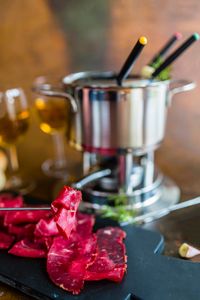
Beef Fondue for Christmas: A Festive Tradition to Warm Your Holiday Gatherings
Discover the Rich History of Fondue and How to Host an Unforgettable Christmas Fondue Night
When our daughter was little, we had a cherished family tradition of spending Christmas and New Year’s skiing in Switzerland. Those trips were filled with laughter, snowy adventures, and, of course, fondue. Whether it was a bubbling pot of cheese fondue or a sizzling beef fondue, both became staples of our holiday celebrations. These hearty and interactive meals were the perfect way to warm up after a day on the slopes and create unforgettable memories around the table.
A Personal Fondue Tradition
Over the years, fondue became more than just a meal for our family—it became a symbol of togetherness. During the cold winter months, I often host fondue parties at home. There’s something magical about gathering friends and family around the table, sharing stories, and cooking together. Fondue, whether cheese or beef, turns a simple dinner into an experience.
Beef fondue, or Fondue Bourguignonne, is particularly special to me. I love selecting the perfect cuts of beef, preparing an array of flavorful dipping sauces, and setting the table with care. It’s a meal that invites conversation and connection, which is exactly what the holiday season is all about.
The Origin of Fondue
Fondue has deep roots in Swiss culture. While cheese fondue originated as a way for Alpine shepherds to make use of hardened cheese and stale bread, beef fondue hails from the Burgundy region of France. The concept is simple yet brilliant: bite-sized pieces of tender beef are cooked in hot oil or broth, then dipped in a variety of sauces. This communal cooking style quickly gained popularity and became a cherished part of holiday traditions across Europe.
How to Create a Fabulous Fondue Evening
1. Choose Your Cooking Base
For an authentic Swiss beef fondue experience, the traditional choice is hot oil. Grape seed oil is often considered the best option due to its high smoke point and neutral flavor, ensuring the beef cooks perfectly without imparting any unwanted taste. Peanut oil is another excellent alternative, offering similar benefits. Both oils provide a crisp, golden exterior on the beef, making each bite deliciously satisfying.
2. Select the Perfect Beef
Quality matters here. I recommend cuts like filet mignon or sirloin, which stay tender and juicy even when cooked quickly. Be sure to cut the beef into uniform cubes for even cooking.
3. Prepare a Selection of Sauces
One of the joys of beef fondue is the variety of sauces. Some of my go-to favorites include:
Béarnaise for a classic French touch
Garlic aioli for a creamy, savory flavor
Honey mustard sauce for a kick
A tangy blue cheese dip
Creamy ginger sauce
Marie Rose sauce
4. Add Simple, Complementary Sides
To balance the richness of the beef, I like to serve steamed vegetables, roasted baby potatoes, and a fresh salad. And let’s not forget crusty bread to soak up all those delicious sauces!
5. Create a Warm Atmosphere
A fondue party is as much about ambiance as it is about the food. I love setting the table with candles and a few simple holiday decorations. It creates a cozy, inviting space where everyone feels at ease.
Fondue: A Meal That Brings People Together
There’s something wonderfully interactive about fondue. Everyone gets involved, from cooking their own bites to passing around sauces and sides. It’s a relaxed and engaging way to dine, and for me, it embodies the spirit of the holiday season.
If you’re looking for a way to make your Christmas gatherings extra special, consider hosting a fondue evening. It’s a meal that combines delicious food with the joy of togetherness—a true recipe for holiday magic.
Want more holiday inspiration and delicious recipes? Check out my Christmas Recipe Collection Cookbook for even more recipes to make your holiday season unforgettable!
#BeefFondue #FondueNight #HolidayEntertaining #FestiveMeals #InteractiveDining #WinterWarmers #SwissCuisine #ComfortFood #FoodieFavorites #GatherAroundTheTable #CookingTogether #FondueBourguignonne #HolidayTraditions #CozyDining #ChristmasDinnerIdeas
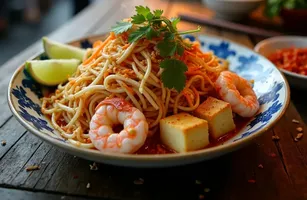
Quick and Easy Pad Thai with Shrimp and Tofu
A Flavorful and Healthy Take on a Thai Classic—Ready in No Time!
My go to meal when craving the bold, tangy, and savory flavors of Thai cuisine.
Here is my Quick Pad Thai with Shrimp and Tofu! This dish is a perfect balance of sweet, salty, and spicy, featuring chewy rice noodles, tender shrimp, and protein-packed tofu. It’s quick to make and perfect for weeknight dinners or when you’re short on time but still want something delicious.
With simple ingredients and a few easy steps, you can bring the taste of Thailand to your table in under 30 minutes.
Why You’ll Love This Quick Pad Thai is because it's fast and easy and perfect for busy nights. This recipe comes together quickly without sacrificing flavor.
It's healthy and balanced: packed with lean protein from shrimp and tofu, plus fiber from fresh veggies and noodles.
It's customizable: Adjust the spice level or swap out ingredients to suit your taste.
Ingredients:
200g (7 oz) rice noodles
2 tablespoons vegetable oil (or peanut oil)
2 garlic cloves, minced
2 eggs, lightly beaten
200g (7 oz) shrimp, peeled and deveined
1 block (300g) firm tofu, cubed
3 tablespoons Pad Thai sauce (store-bought or homemade)
1 tablespoon soy sauce or tamari (for a gluten-free option)
1 cup fresh bean sprouts
3 green onions, chopped
¼ cup crushed roasted peanuts
Optional Garnishes:
Lime wedges
Thai chili flakes, sriracha, or chili paste for heat
Thai basil or cilantro for freshness
Preparation:
Cook the rice noodles according to package instructions. Drain and set aside.
Cook the Shrimp and Tofu, heat 1 tablespoon of oil in a large skillet or wok over medium-high heat. Add the shrimp and tofu, cooking until the shrimp turn pink and the tofu is golden, about 3-4 minutes. Remove and set aside.
Add another tablespoon of oil to the skillet. Pour in the beaten eggs and scramble until just set.
Add the cooked noodles, shrimp, and tofu back into the skillet. Pour in the Pad Thai sauce and soy sauce, tossing everything together to coat evenly. Cook for 2-3 minutes until heated through.
Stir in the bean sprouts and green onions, cooking for 1 more minute.
Divide the Pad Thai into bowls and top with crushed peanuts, lime wedges, and your choice of Thai chili flakes or sriracha for an extra kick.
This quick Pad Thai is a perfect example of how you can enjoy classic restaurant flavors at home. The combination of shrimp and tofu provides a healthy protein boost, while the rice noodles offer the perfect chewy texture. The fresh bean sprouts and lime add brightness, and the peanuts give a satisfying crunch. Best of all, it’s customizable—adjust the spice, swap out the proteins, or add more veggies to make it your own.
If you’re looking for a quick, healthy, and incredibly flavorful meal, this quick Pad Thai with shrimp and tofu is the way to go. It’s a satisfying dish that brings the vibrant flavors of Thai cuisine right to your kitchen in no time.
#QuickPadThai
#HealthyThaiRecipes
#ShrimpAndTofu
#EasyWeeknightMeals
#ThaiCuisine
#FlavorfulNoodles

Pickling Sausages and Tomatoes: A Flavorful Tradition from the Czech Republic
Discover the Tangy Delight of Utopenci and Pickled Tomatoes in My Culinary Journey
Growing up, I never imagined that sausages and tomatoes could be transformed into something so tangy, bold, and delicious.It wasn’t until my travels through the Czech Republic that I stumbled upon the art of pickling these humble ingredients. Known locally as Utopenci, pickled sausages are a beloved snack in Czech pubs, often paired with a cold beer. Similarly, pickled tomatoes, with their sweet and tangy balance, are a staple in Czech homes, adding a burst of flavor to any meal.
In this post, I’ll share the fascinating history behind these pickled delights, how I discovered them, and how you can bring a taste of the Czech Republic to your kitchen.
A Taste of the Czech Republic
Pickling sausages and tomatoes is more than just a method of preservation; it’s a celebration of bold, tangy flavors and a connection to Czech culinary traditions. Whether you’re preparing Utopenci for a pub-style snack or pickled tomatoes to brighten up your meals, these recipes bring a taste of the Czech Republic to your table.
The Origin of Utopenci: Czech Pickled Sausages
Utopenci, which translates to "drowned men," has a unique backstory. Legend has it that the dish was invented by a miller who accidentally dropped sausages into a barrel of brine. To his surprise, the sausages not only preserved well but also absorbed the tangy, spicy flavors of the pickling liquid. Over time, this dish became a pub favorite, often enjoyed with a frothy glass of Czech pilsner.
What makes Utopenci so special is its simplicity and bold flavor. The sausages, usually sliced or whole, are pickled in a vinegar-based brine infused with onions, garlic, and spices. The result? A snack that’s tangy, slightly spicy, and utterly addictive.
The Charm of Pickled Tomatoes, another delicious way of eating tomatoes.
Pickled tomatoes, on the other hand, offer a different kind of magic. In the Czech Republic, they are often made with small, ripe tomatoes preserved in a sweet and tangy brine. These tomatoes are perfect as a side dish, a salad topping, or even enjoyed on their own as a quick snack.
I first encountered pickled tomatoes during a visit to a small Czech village, where they were served alongside hearty roasted meats and fresh bread. The tanginess of the tomatoes perfectly complemented the richness of the meal, and I was instantly hooked.
How to pickle sausages and tomatoes at home
Ingredients for Utopenci (Pickled Sausages):
500g (1 lb) cooked sausages (e.g., bratwurst or frankfurters)
1 cup white vinegar
1 cup water
2 tablespoons sugar
1 tablespoon salt
1 onion, thinly sliced
2 garlic cloves, smashed
1 teaspoon black peppercorns
1 teaspoon mustard seeds
1 bay leaf
Optional: chili flakes for heat
Ingredients for Pickled Tomatoes:
500g (1 lb) small ripe tomatoes (e.g., cherry or plum)
1 cup white vinegar
1 cup water
2 tablespoons sugar
1 tablespoon salt
2 garlic cloves, sliced
1 teaspoon dill seeds or fresh dill
Optional: red chili for a spicy kick
Preparation:
For both Utopenci and pickled tomatoes, combine the vinegar, water, sugar, salt, and spices in a saucepan. Bring the mixture to a boil, stirring until the sugar and salt dissolve.:
For Utopenci, place the sausages and sliced onions in a clean glass jar. Pour the hot brine over them, ensuring everything is submerged.
For pickled tomatoes, pierce each tomato with a fork, then place them in a jar. Pour the brine over the tomatoes.
Then, seal the jars tightly and let them cool to room temperature before refrigerating. Allow at least 24 hours for Utopenci and 48 hours for pickled tomatoes to develop their full flavor.
Serving Suggestions:
Utopenci: Enjoy as a snack, serve with crusty bread, or pair with a cold beer for an authentic Czech experience.
Pickled Tomatoes: Use as a tangy side dish, a topping for salads, or a flavorful addition to sandwiches.
Are you ready to try your hand at pickling? Let’s make it!
#PickledTomatoes
#HomemadePickling
#PreservingTraditions
#CzechCuisine
#TangyFlavors
#ArtisanPickles
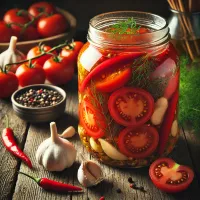
Homemade pickled tomatoes

Walking Dinners: The Modern, Stress-Free Way to Host a Festive Holiday Feast
Stress-Free Holiday Entertaining: Your Ultimate Guide to Walking Dinners
The holiday season should be about joy and connection, not stress. But with elaborate menus and long hours in the kitchen, hosting can feel overwhelming. That’s where walking dinners come in—a modern, relaxed way to entertain. Perfect for any space, walking dinners let your guests enjoy a variety of small bites while mingling. No formal seating, no stress—just delicious food and good vibes.
Let’s explore how to host a seamless walking dinner, complete with menu ideas, preparation tips, and a timeline to keep you on track. For even more holiday hosting inspiration, check out the other tips and suggestions on my blog!
Often people ask me: What Exactly is a Walking Dinner?
A walking dinner is like a sophisticated buffet where guests enjoy bite-sized dishes while moving around. It’s ideal for casual gatherings, allowing people to socialize freely without the structure of a sit-down meal. Whether you’re hosting a cozy Christmas party or a New Year’s Eve celebration, walking dinners add a fun, interactive touch to your event.
2. Crafting the Perfect Walking Dinner Menu
A successful walking dinner menu offers variety and caters to different dietary preferences. Here’s how to build yours:
Cold Starters to Set the Tone
Easy-to-prepare and beautifully presented options like Caprese skewers, smoked salmon rolls, or beet carpaccio are perfect. They’re light, refreshing, and can be made ahead of time.
Warm, Hearty Bites
Keep your guests satisfied with warm dishes like mini quiches, stuffed mushrooms, or meatball skewers. Use your crockpot or oven to keep these warm without constant supervision.
Vegetarian Favorites
Options like mini falafel bites, roasted vegetable skewers, or spanakopita pastries are flavorful crowd-pleasers.
Showstopping Centerpieces
Create a stunning charcuterie board or a seafood platter as the focal point. Guests can snack as they please while admiring your festive spread.
Sweet Endings
▪︎ Mini desserts like chocolate mousse cups, macarons, or festive fruit tarts ensure your guests leave on a sweet note.
Here’s a simple timeline to keep your planning smooth and stress-free:
1 Week Before
▪︎ Finalize your menu and make a detailed shopping list.
▪︎ Order any specialty items like artisanal cheeses or fresh seafood.
3 Days Before
▪︎ Shop for groceries.
▪︎ Start prepping cold starters and desserts.
1 Day Before
▪︎ Cook warm dishes that can be reheated on the event day.
▪︎ Set up serving stations with festive decorations like fairy lights and pinecones.
Day of the Event
▪︎ Assemble and plate cold dishes.
▪︎ Warm up hot dishes just before guests arrive.
▪︎ Add finishing touches to your charcuterie board or centerpiece platter.
Set the Scene for a Festive Vibe
Walking dinners thrive on a cozy, inviting atmosphere. Use soft lighting with candles or fairy lights, and decorate with holiday accents like greenery, ornaments, or rustic serving pieces. Make your walking dinner even more memorable by including interactive elements. A DIY crostini bar or a dessert fondue station invites guests to get creative, making the experience fun and engaging.
Walking dinners are the ultimate way to host a stress-free, modern holiday gathering. They’re versatile, easy to prepare, and perfect for creating a festive atmosphere without the fuss of a formal dinner.
For more tips, menu ideas, and hosting inspiration, explore the holiday entertaining section on this blog. Let’s make this holiday season your best yet—full of delicious bites, laughter, and zero stress!
#WalkingDinner #HolidayHosting #StressFreeEntertaining
#ModernHolidayTrends #FingerFoodFeast #FestiveVibes
#HolidayPartyIdeas #EasyEntertaining #FoodieLife
#ChristmasCelebrations #CozyGatherings #InteractiveDining
#BiteSizedDelights

An example of different small bites for a Walking Dinner
Impress your guests with an elegant selection of finger foods, beautifully served in a variety of small glasses. From colorful layered salads to creamy dessert mousses and savory bites, each glass is a miniature work of art. These perfectly portioned delights add a chic, sophisticated touch to any event, making your spread as stylish as it is delicious.

Get to Know Sinterklaas: A Cherished Dutch Tradition for All Ages (+ Speculaas Recipe!)
In the Netherlands, few traditions bring as much joy and excitement as Sinterklaas. Celebrated on December 5th, this beloved holiday is eagerly awaited by both young and old. It marks the birthday of Sinterklaas, a figure steeped in history and warmth, who travels across the country with his helpers, the Pieten, to deliver gifts and sweet treats.
The Magic of Sinterklaas
The celebration begins weeks in advance, as Sinterklaas arrives by boat from Spain, an event televised and joyfully followed by families. On the eve of December 5th, known as pakjesavond (gift evening), families gather to exchange presents, often accompanied by playful rhymes and personalized poems. It's a night filled with laughter, surprises, and delicious holiday treats.
One of the most iconic treats of this season is speculaas, a spiced Dutch cookie that embodies the warmth and comfort of the holiday. Crisp and fragrant, speculaas is traditionally shaped using carved wooden molds that depict festive figures like Sinterklaas himself.
What is Speculaas?
Speculaas is a spiced shortcrust cookie known for its rich, aromatic blend of spices, including cinnamon, cloves, and nutmeg. These spices not only make the cookies incredibly flavorful but also fill your home with the most delightful holiday scent as they bake. While traditionally enjoyed during the Sinterklaas season, they’re so delicious that many enjoy them year-round.
A Special Recipe for a Special Day
To help you fully embrace this cherished Dutch tradition, I’m sharing my favorite recipe for homemade speculaas. Whether you’re celebrating Sinterklaas for the first time or reliving fond memories, these cookies are sure to bring warmth and cheer to your home.
Classic Speculaas Recipe
(Recipe details here, as provided earlier)
Embrace the Tradition
Whether you’re a long-time fan of Sinterklaas or new to this delightful holiday, making speculaas is a wonderful way to connect with Dutch culture and create cherished memories. Gather your loved ones, roll out some dough, and enjoy the sweet, spiced taste of tradition.
Happy Sinterklaas!
#Sinterklaas #DutchTraditions #HolidayBaking #SpeculaasRecipe #FestiveCookies #DutchCulture #FamilyTraditions #ChristmasInTheNetherlands #DutchHolidays #SpicedCookies

Speculaas Recipe
Classic Speculaas Recipe
Ingredients
250g (2 cups) all-purpose flour
150g (3/4 cup) brown sugar
150g (2/3 cup) unsalted butter, chilled and cubed
2 tbsp milk
2 tsp ground cinnamon
1 tsp ground ginger
1/2 tsp ground cloves
1/2 tsp ground nutmeg
1/4 tsp ground cardamom (optional)
1/2 tsp baking powder
Pinch of salt
Slivered almonds for decoration (optional)
Preparation::
1. Mix the Dry Ingredients
In a large bowl, whisk together the flour, brown sugar, spices, baking powder, and salt.
2. Incorporate the Butter
Add the cubed butter to the dry ingredients. Using your fingers or a pastry cutter, rub the butter into the mixture until it resembles coarse crumbs.
3. Form the Dough
Add the milk and mix until the dough comes together. Knead lightly, then form a ball. Wrap the dough in plastic wrap and refrigerate for at least 1 hour (or overnight for a more intense flavor).
4. Preheat the Oven
Preheat your oven to 180°C (350°F) and line a baking sheet with parchment paper.
5. Shape the Cookies
Roll out the dough on a lightly floured surface to about 0.5 cm (1/4 inch) thickness. Use cookie cutters or shape traditionally with wooden speculaasplank molds. If using molds, press dough into the mold, then tap to release. Decorate with slivered almonds if desired.
6. Bake
Place cookies on the prepared baking sheet and bake for 10-12 minutes, or until golden brown. Let them cool on the sheet for a few minutes before transferring to a wire rack.
7. Serve and Enjoy
Enjoy your speculaas with a cup of coffee or warm cocoa!
